-
 Bando Mitsugorō III as Lady Iwafuji and Nakamura Matsue III as Lady Onoe, 1821.「局岩ふじ 坂東三津五郎」(三代)、「中老尾上 中村松江」(三代) in kabuki play Kagamiyama Kokyô no Nishikie [鏡山旧錦繪] (Mirror mountain: A women’s treasury of loyalty); author: Yô Yôdai. Artist: Shunkōsai Hokushū (春好斎 北洲), who is also known as Shunkō IV, active from about 1802 to 1832. Actors: Bandō Mitsugorō III [三代目 坂東 三津五郎] (Japanese, 1775 – 1831); other names: Bandō Minosuke I, Morita Kanjirô II, Bandō Mitahachi I, Bandō Minosuke I, Bandō Mitahachi I. Nakamura Matsue III [三代目中村松江] (Japanese, 1786-1855); other names: Nakamura Sankō I, Nakamura Tomijūrō II, Ichikawa Kumatarō. Year: 1821 (Bunsei 4), 1st month. Publisher: Wataya Kihei (Wataki) (Japanese, fl. c. 1809 – 1885) Signed Shunkôsai Hokushû ga 春好斎北洲画. MFA Accession № 11.35375. MFA description: "Play: Keisei Kagamiyama (Mirror Mountain, a Courtesan Play). Theatre: Kado けいせい双鏡山(けいせいかがみやま)角. Ref.: [LIB-1193.2013] Leiter. Kabuki Encyclopedia, p. 156; [LIB-0879-2.2015] Kabuki plays on stage (vol. 2): 1773-1799, pp. 172-212.
Bando Mitsugorō III as Lady Iwafuji and Nakamura Matsue III as Lady Onoe, 1821.「局岩ふじ 坂東三津五郎」(三代)、「中老尾上 中村松江」(三代) in kabuki play Kagamiyama Kokyô no Nishikie [鏡山旧錦繪] (Mirror mountain: A women’s treasury of loyalty); author: Yô Yôdai. Artist: Shunkōsai Hokushū (春好斎 北洲), who is also known as Shunkō IV, active from about 1802 to 1832. Actors: Bandō Mitsugorō III [三代目 坂東 三津五郎] (Japanese, 1775 – 1831); other names: Bandō Minosuke I, Morita Kanjirô II, Bandō Mitahachi I, Bandō Minosuke I, Bandō Mitahachi I. Nakamura Matsue III [三代目中村松江] (Japanese, 1786-1855); other names: Nakamura Sankō I, Nakamura Tomijūrō II, Ichikawa Kumatarō. Year: 1821 (Bunsei 4), 1st month. Publisher: Wataya Kihei (Wataki) (Japanese, fl. c. 1809 – 1885) Signed Shunkôsai Hokushû ga 春好斎北洲画. MFA Accession № 11.35375. MFA description: "Play: Keisei Kagamiyama (Mirror Mountain, a Courtesan Play). Theatre: Kado けいせい双鏡山(けいせいかがみやま)角. Ref.: [LIB-1193.2013] Leiter. Kabuki Encyclopedia, p. 156; [LIB-0879-2.2015] Kabuki plays on stage (vol. 2): 1773-1799, pp. 172-212. -
 Richard Parkes Bonington (1802–1828 ). British/French. Evreux: Tour du Gros Horloge (Evreux: Large Clock Tower). Inscription: The tower was built in 1417 when the area was ruled by England. Lithograph. From the Taylor and Nodier set "Normandie", Vol. II, pl. 226. 1824. MET# 22.87.2. Catalogue Raisonné: Curtis 1939, no. 19. MET description: "This view in the French town of Evreux focuses on the clock tower, with vendors and customers in the street below. Bonington produced the print for the multi-volume series directed by Baron Isidore Taylor, Charles Nodier and Alphonse de Cailleux titled "Voyages Pittoresques et Romantiques dans l'Ancienne France" (Picturesque and Romantic Travels through Historic France). This image appears in volume 2, devoted to Normandy."
Richard Parkes Bonington (1802–1828 ). British/French. Evreux: Tour du Gros Horloge (Evreux: Large Clock Tower). Inscription: The tower was built in 1417 when the area was ruled by England. Lithograph. From the Taylor and Nodier set "Normandie", Vol. II, pl. 226. 1824. MET# 22.87.2. Catalogue Raisonné: Curtis 1939, no. 19. MET description: "This view in the French town of Evreux focuses on the clock tower, with vendors and customers in the street below. Bonington produced the print for the multi-volume series directed by Baron Isidore Taylor, Charles Nodier and Alphonse de Cailleux titled "Voyages Pittoresques et Romantiques dans l'Ancienne France" (Picturesque and Romantic Travels through Historic France). This image appears in volume 2, devoted to Normandy." -
 Utagawa Kunisada [歌川 国貞] a.k.a. Utagawa Toyokuni III [三代歌川豊国] (Japanese, 1786 – 1865)
Utagawa Kunisada [歌川 国貞] a.k.a. Utagawa Toyokuni III [三代歌川豊国] (Japanese, 1786 – 1865)Promotional fan for a hairpin shop, with a poem by Ichikawa Danjuro VII, signed Hakuen.
Date seal plus rectangular kiwame seal: Bunsei 8 (1825).
Size: Fan print. Uchiwa-e (27.5 x 21.1 cm) Publisher seal: Maru-To (2) (Marks U204). Date seal plus rectangular kiwame seal: Bunsei 8 (1825). -
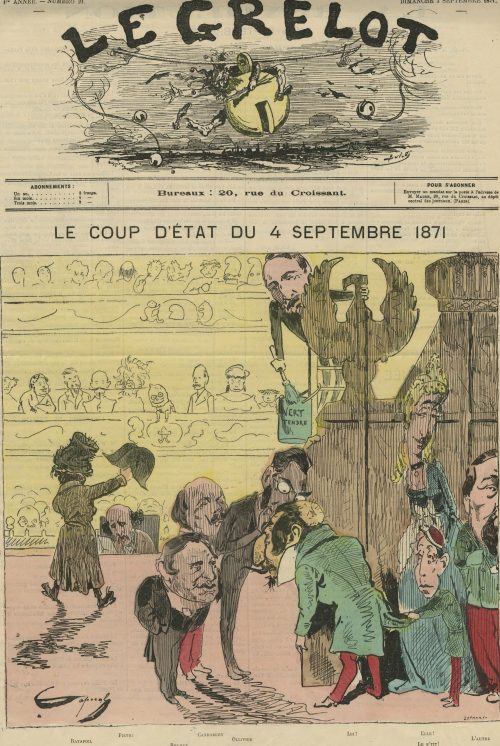 Le Grelot / journal illustré politique et satirique, №21, dimanche, 3 septembre 1871. Artist: Caporal (signed in the lower-left corner) Engraver/Printer: J. Lefman (signed LEFMAN SC in the lower-right corner) Title: LE COUP D'ÉTAT DU 4 SEPTEMBRE 1871. The Coup d'Etat of September 4th 1871. The artist equalled the 4th of September revolution when Napoleon III was ousted and the Second Empire collapsed, to a coup d'Etat. Although the number is marked September 3, it is dedicated to the events of September 4th. This was a usual French newspaper practice to postdate their issues. That's why they almost always operated with categories such as "today", "yesterday", and "tomorrow" instead of definitive calendar dates. "Le Grelot" means "The Sleigh Bell". Personages: Ratapoil – fictional personage invented by Honoré Daumier (French, 1808 – 1879), a Napoleon III caricaturized figure. Ratapoil is addressing the audience holding up Napoléon Bonaparte's tricorn cocked hat. Pietri – Joseph Marie Piétri [Joachim Piétri] (French, – is sitting in the first row, taking notes. Rouher – Eugène Rouher (French, 1814 – 1884), president of the Senat. Canrobert – François Marcellin Certain de Canrobert (French, 1809 – 1895), French Marshal, captured by the Prussian army in Metz with Marshal Bazaine during the surrender of Metz on October 28, 1870. Ollivier – Olivier Émile Ollivier (French, 1825 – 1913), head of the government. Hiding behind the theater decoration are: Napoleon III (Lui!), his wife Eugénie (Elle!), their son Prince Imperial (Le P'tit!), and Pierre Bonaparte (L'Autre). Sitting in the theatre box facing the scene: Adolphe Thiers (French, 1797 – 1877), Jules Favre (French, 1809 – 1880), Louis-Jules Trochu [Le General Trochu] (French, 1815 – 1896), and the other members of the "Government of National Defence". On the gallery: youngsters and two men in sans-culottes hats. An unidentified person on a ladder holding to an eagle figure is having a paintbrush and a bucket with 'tender green' paint. Ref: Musée Carnavalet
Le Grelot / journal illustré politique et satirique, №21, dimanche, 3 septembre 1871. Artist: Caporal (signed in the lower-left corner) Engraver/Printer: J. Lefman (signed LEFMAN SC in the lower-right corner) Title: LE COUP D'ÉTAT DU 4 SEPTEMBRE 1871. The Coup d'Etat of September 4th 1871. The artist equalled the 4th of September revolution when Napoleon III was ousted and the Second Empire collapsed, to a coup d'Etat. Although the number is marked September 3, it is dedicated to the events of September 4th. This was a usual French newspaper practice to postdate their issues. That's why they almost always operated with categories such as "today", "yesterday", and "tomorrow" instead of definitive calendar dates. "Le Grelot" means "The Sleigh Bell". Personages: Ratapoil – fictional personage invented by Honoré Daumier (French, 1808 – 1879), a Napoleon III caricaturized figure. Ratapoil is addressing the audience holding up Napoléon Bonaparte's tricorn cocked hat. Pietri – Joseph Marie Piétri [Joachim Piétri] (French, – is sitting in the first row, taking notes. Rouher – Eugène Rouher (French, 1814 – 1884), president of the Senat. Canrobert – François Marcellin Certain de Canrobert (French, 1809 – 1895), French Marshal, captured by the Prussian army in Metz with Marshal Bazaine during the surrender of Metz on October 28, 1870. Ollivier – Olivier Émile Ollivier (French, 1825 – 1913), head of the government. Hiding behind the theater decoration are: Napoleon III (Lui!), his wife Eugénie (Elle!), their son Prince Imperial (Le P'tit!), and Pierre Bonaparte (L'Autre). Sitting in the theatre box facing the scene: Adolphe Thiers (French, 1797 – 1877), Jules Favre (French, 1809 – 1880), Louis-Jules Trochu [Le General Trochu] (French, 1815 – 1896), and the other members of the "Government of National Defence". On the gallery: youngsters and two men in sans-culottes hats. An unidentified person on a ladder holding to an eagle figure is having a paintbrush and a bucket with 'tender green' paint. Ref: Musée Carnavalet -
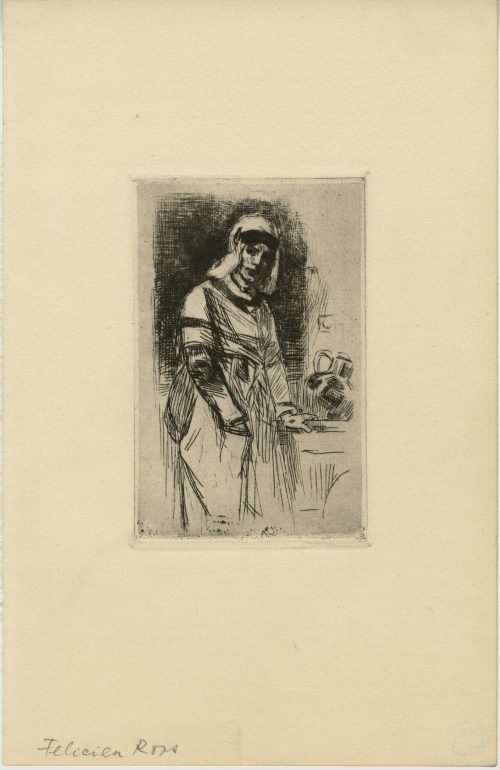
A woman from Antwerp or a servant, another title "Laitière anversoise"; 2nd state. Etching on wove paper. Owner's stamp LVM on verso.
Dimensions: Paper: 24.4 x 15.8 cm; Image: 12 x 7.5 cm
Catalogue raisonné: Arthur Hubschmid (1977): 343.
-
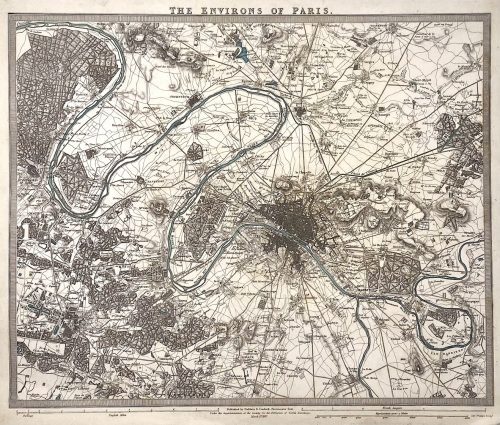 Top: THE ENVIRONS OF PARIS. || Bottom centre: Published by Baldwin & Cradock, Paternoster Row, | Under the Superintendence of the Society for the Diffusion of Useful Knowledge. | March 1st. 1832. || Bottom right: J. & C. Walker sculpt. || Dimensions: Sheet: 34.7 x 40.5 cm; Image: 30 x 37 cm. Contributors: J & C Walker (British firm, fl. 1820 – 1895) Walker, John (British, 1787 – 1873) Walker, Alexander (British, 1797? – 1870) Walker, Charles (British, 1799? – 1872) Society for the Diffusion of Useful Knowledge (SDUK) (British firm, 1826 – 1846)
Top: THE ENVIRONS OF PARIS. || Bottom centre: Published by Baldwin & Cradock, Paternoster Row, | Under the Superintendence of the Society for the Diffusion of Useful Knowledge. | March 1st. 1832. || Bottom right: J. & C. Walker sculpt. || Dimensions: Sheet: 34.7 x 40.5 cm; Image: 30 x 37 cm. Contributors: J & C Walker (British firm, fl. 1820 – 1895) Walker, John (British, 1787 – 1873) Walker, Alexander (British, 1797? – 1870) Walker, Charles (British, 1799? – 1872) Society for the Diffusion of Useful Knowledge (SDUK) (British firm, 1826 – 1846) -
 Superb Edo pictures illustrating dances (Odori keiyô Edo-e no sakae): Interior of an imaginary theater with a performance of Shibaraku 「踊形容江戸絵栄」. Artist: Utagawa Kunisada [歌川 国貞] a.k.a. Utagawa Toyokuni III [三代歌川豊国] (Japanese, 1786 – 1865). Publisher: Nōshūya Yasubei (Japanese, fl. c. 1851 – 1870). Year: 1858 (Ansei 5), 7th month. Size: Vertical ôban triptych; 36.9 x 75.7 cm. Signed: 一陽斎雛獅豊国筆(年玉印) – Ichiyôsai Hinashi Toyokuni ga (on left sheet only). Censor's seal: Horse 7 [午七 彫師]. Subject: Shibaraku. Ref.: MFA impression: 11.44263a-c; Robert Schaap. Kunisada (2016), p. 101 [LIB-1212.2017]. Ref.: [LIB-1197.2016] Arendie and Henk Herwig. Heroes of the kabuki stage: an introduction to kabuki with retellings of famous plays, illustrated by woodblock prints. — Amsterdam: Hotei Publishing, 2004; p. 38.
Superb Edo pictures illustrating dances (Odori keiyô Edo-e no sakae): Interior of an imaginary theater with a performance of Shibaraku 「踊形容江戸絵栄」. Artist: Utagawa Kunisada [歌川 国貞] a.k.a. Utagawa Toyokuni III [三代歌川豊国] (Japanese, 1786 – 1865). Publisher: Nōshūya Yasubei (Japanese, fl. c. 1851 – 1870). Year: 1858 (Ansei 5), 7th month. Size: Vertical ôban triptych; 36.9 x 75.7 cm. Signed: 一陽斎雛獅豊国筆(年玉印) – Ichiyôsai Hinashi Toyokuni ga (on left sheet only). Censor's seal: Horse 7 [午七 彫師]. Subject: Shibaraku. Ref.: MFA impression: 11.44263a-c; Robert Schaap. Kunisada (2016), p. 101 [LIB-1212.2017]. Ref.: [LIB-1197.2016] Arendie and Henk Herwig. Heroes of the kabuki stage: an introduction to kabuki with retellings of famous plays, illustrated by woodblock prints. — Amsterdam: Hotei Publishing, 2004; p. 38.
-
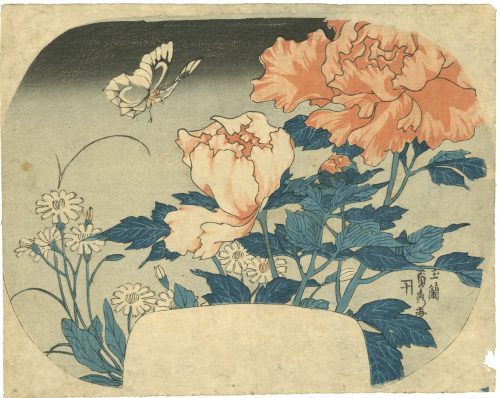 Artist: Utagawa Sadahide [歌川貞秀] (Japanese, 1807 – 1879) Publisher: Kojimaya Jūbei [小島屋重兵衛] (Japanese, c. 1797 – 1869) No date seal, no censor seal (privately printed?) Media: Fan print (uchiwa-e, 団扇絵), 235 x 297 mm. Kalimeris incisa, or Japanese Aster, is a daisy-like flower that belongs to the family of Asteraceae; it blossoms all summer and attracts butterflies. Peony [牡丹] (botan) – per Merrily Baird it is "the king of flowers", associated with erotic love, and especially with the sexual activities of women.
Artist: Utagawa Sadahide [歌川貞秀] (Japanese, 1807 – 1879) Publisher: Kojimaya Jūbei [小島屋重兵衛] (Japanese, c. 1797 – 1869) No date seal, no censor seal (privately printed?) Media: Fan print (uchiwa-e, 団扇絵), 235 x 297 mm. Kalimeris incisa, or Japanese Aster, is a daisy-like flower that belongs to the family of Asteraceae; it blossoms all summer and attracts butterflies. Peony [牡丹] (botan) – per Merrily Baird it is "the king of flowers", associated with erotic love, and especially with the sexual activities of women. -
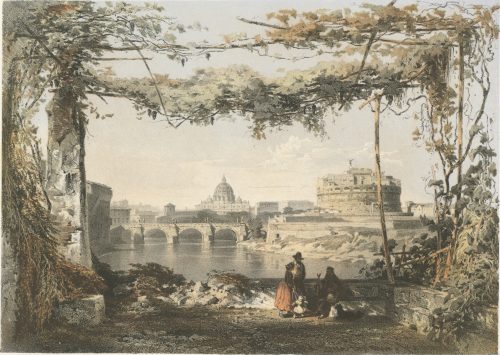
Sheet № 20 from the series of 42 сhromolithography prints 'Skizzen und Bilder aus ROM und der Umgegend' (Sketches and pictures from Rome and surroundings).
Inscriptions:
Top left: LINDEMANN-FROMMEL’S Top right: Skizzen und Bilder aus ROM und der Umgegend. Centre below: No 20 | IL CASTEL E IL PONTE SANT ANGELO, | E SAN PIETRO. Bottom left: Imp. de JACOMME et Cie. R. de Lancry, 16 Paris. Bottom centre: Stuttgart, bei FRANZ KÖHLER. Bottom right: Paris, Goupil et Cie. Editeurs.Dimensions:
Plate: 372 x 473 mm Sheet: 372 x 473 mm
Contributors:
Lindemann-Frommel, Karl (French-German, 1819 – 1891) – artist. Jacomme, Claude (French, fl. 1838 – 1857) – printer/lithographer. Goupil et Cie (Paris); Goupil, Adophe (French, 1806 – 1893) – publisher Franz Köhler (Stuttgart); Köhler, Franz (German, 1805 – 1872) – publisher. -
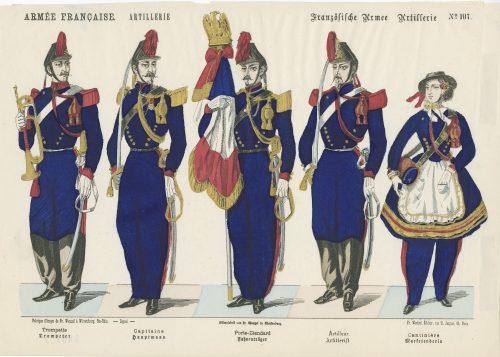 Hand-coloured woodcut on wove paper, 265 x 378 mm; black ink stamp “5051 1” to reverse. Top left: "ARMÉE FRANCAISE. ARTILLERIE"; right: (gothic font) "Französische Armee Artillerie" — "№ 107". Below left: "Fabrique d’Images de Fr. Wentzel à Wissembeurg. Bas-Rhin." — "Déposé" —, centre: "Bilderfabrit von Fr. Wentzel in Weissenburg", right: "Fr. Wentzel, Éditeur, rue St. Jacques, 65, Paris". Bottom: "Trompette | Trompeter" — "Capitaine | Gauptmann" — "Porte-Étendard | Fahnenträger" — "Artilleur | Artillerist" — "Cantinière | Marketenderin". Jean Frédéric Wentzel (French, 1807 – 1869) – publisher/printer.
Hand-coloured woodcut on wove paper, 265 x 378 mm; black ink stamp “5051 1” to reverse. Top left: "ARMÉE FRANCAISE. ARTILLERIE"; right: (gothic font) "Französische Armee Artillerie" — "№ 107". Below left: "Fabrique d’Images de Fr. Wentzel à Wissembeurg. Bas-Rhin." — "Déposé" —, centre: "Bilderfabrit von Fr. Wentzel in Weissenburg", right: "Fr. Wentzel, Éditeur, rue St. Jacques, 65, Paris". Bottom: "Trompette | Trompeter" — "Capitaine | Gauptmann" — "Porte-Étendard | Fahnenträger" — "Artilleur | Artillerist" — "Cantinière | Marketenderin". Jean Frédéric Wentzel (French, 1807 – 1869) – publisher/printer. -
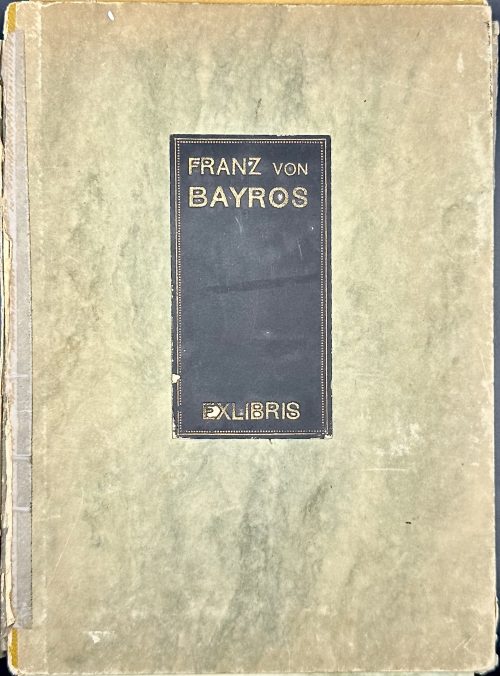 A set of 49 prints, heliogravures and etchings, tipped-in on 285 x 257 mm grey cards, in a green marbled folder with a gilt-lettered black label to the front. No publisher, no place, no year (s.l., s.n., s.d.), printed in circa 1910.
A set of 49 prints, heliogravures and etchings, tipped-in on 285 x 257 mm grey cards, in a green marbled folder with a gilt-lettered black label to the front. No publisher, no place, no year (s.l., s.n., s.d.), printed in circa 1910.- Vlastimil Blažek (Czech, 1878 – 1950): heliogravure, sheet 180 x 137 mm, plate 152 x 114 mm; laid paper, black sepia ink; unsigned.
- Ex libris Gerhard Wunderlich (architect in Dresden): heliogravure, sheet 205 x 150 mm, plate 158 x 115 mm; wove paper, brown sepia ink; inscription: heliogravure, sheet 180 x 137 mm, plate 152 x 114 mm; laid paper, sepia ink; inscription to top “Es ist alles so eng”; signed “F (backwards). Bayros”.
- Ex libris William Lipka: heliogravure, sheet 140 x 125 mm, plate 112 x 98 mm; laid paper, black sepia ink; signature hardly legible.
- Nikolaus Schindler (amateur photographer in Vienna): heliogravure, sheet 142 x 150 mm, plate 110 x 117 mm; laid paper, black sepia ink; unsigned.
- Sussy de Coiquard: heliogravure, sheet 160 x 140 mm, plate 128 x 110 mm; laid paper, black sepia ink; unsigned.
- Illegible, looks like “Vielluer Febréy”: heliogravure, sheet 120 x 109 mm, plate 93 x 85 mm; laid paper, black, sepia ink; signed “F (backwards). Bayros:”.
- Ex libris Erich Liebermann-Rosswiese (Greman-Jewish, 1886 – 1942): heliogravure, sheet 180 x 139 mm, plate 118 x 88 mm; wove paper, black sepia ink; unsigned.
- Ex libris Dr. phil. Rudolf Ludwig: before letters, heliogravure, sheet 150 x 132 mm, plate 120 x 110 mm; laid paper, black sepia ink; unsigned. See [LIB-3258.2023] John Cleland. Die Memoiren der Fanny Hill. — Paphos [i.e. Vienna]: C. W. Stern, 1906.
- Unidentified: before letters, heliogravure, sheet 150 x 115 mm, plate 113 x 88 mm; laid paper, black sepia ink; signed “F. Bayros” in the manuscript. Circumstantial evidence tells that this bookplate belongs to someone A.W.(Artur Wolf). See №22.
- Lulu. Monachia. Gest. v. Ritter Dialekt und Junker Erich: heliogravure, sheet 204 x 152 mm, plate 160 x 118 mm; wove paper, black sepia ink; unsigned. See №20.
- Kellner Jstván: (István): heliogravure, sheet 118 x 100 mm, plate 85 x 70 mm; laid paper, black sepia ink; signed “Franz Bayros” in the script (hardly legible).
- Adyton: heliogravure, sheet 170 x 130 mm, plate 113 x 85 mm; wove paper, black, sepia ink; signed “F (backwards). Bayros”.
- 13.Ex libris George Arthur Buhl (American, 1883 – 1959): heliogravure, sheet 166 x 140 mm, plate 120 x 92 mm; wove paper, black sepia ink; inscription “!I will! | !And I can!”; bust inscribed “T. Carlyle”; signed “F (backwards). Bayros” (hardly legible).
- Ex-Libris Heinrich und Lise Fuhrmann: heliogravure, sheet 165 x 149 mm, plate 120 x 103 mm; wove paper, black sepia ink; signed “F (backward). Bayros”; inscription “So schaff ich am sausenden Webstuhl der Zeit und wirke der Gottheit lebendiges Kleid” (from ‘Faust’ by Goethe).
- Ex libris Gerhard Wunderlich (architect in Dresden): heliogravure, sheet 165 x 137 mm, plate 135 x 105 mm; laid paper, black, sepia ink; signed “F (backwards). Bayros”.
- Ex Libris Walther u. Amelia Fahrenhorst; Walter Fahrenhorst (German, 1871 – 1938): heliogravure, sheet 165 x 140 mm, plate 128 x 95 mm; wove paper, black sepia ink; signed “F. Bayros” in the manuscript. The inscription behind the strings: NITOR (lat. beauty, glamour).
- Ex Libris Margot Lewknecht; heliogravure, sheet 145 x 140 mm, plate 128 x 118 mm; laid paper, black sepia ink; signed “F. Bayros”.
- Ex Libris Walther Heinisch (publisher in Carlsbad); heliogravure, sheet 185 x 145 mm, plate 140 x 110 mm; wove paper, sanguine; male bust with an inscription to the base: “Arnold Boeklin” / Arnold Böcklin (Swiss, 1827 – 1901); inscription: “mit gêru scal man geba infâhan” – a line from Hildebrandslied, the earliest poetic text in German. Unsigned.
- Bookplate with music score GGDBGC; heliogravure, sheet 125 x 135 mm, plate 100 x 110 mm, with monogram «HCJ»; laid paper, brown sepia ink; signed “F. Bayros”.
- Bookplate with inscription: Lulu aus Praga | Gest v. Ritter Dialekt / Monachia / Monachia / und Junker Erich; heliogravure, sheet 182 x 147 mm, plate 160 x 120 mm, image 122 x 105 mm; wove paper, bluish-black sepia ink; unsigned. See №10.
- Bookplate, no inscription; heliogravure, laid paper, sepia ink, sheet 148 x 127 mm, image 84 x 79 mm; signed F. Bayros in the manuscript beneath the image.
- Ex libris Artur Wolf: heliogravure, laid paper, sepia ink, sheet 170 x 150 mm, image 120 x 105 mm; signed F. Bayros in the manuscript to the frame of the image. See №9.
- Ex Libris E. K. Weigl: heliogravure, laid paper, sepia ink, sheet 139 x 121 mm, plate 112 x 97 mm; unsigned; inscription above male portrait: “LEONARDO”.
- Ex libris Dr. A. Bergmann: heliogravure, wove paper, sepia ink; sheet 180 x 140 mm, plate 130 x 105 mm; signed F. Bayros in the manuscript.
- Grete Cäcilie (monogram “PS”): heliogravure, laid paper, sepia ink, sheet 161 x 130 mm, plate 128 x 103 mm, signature illegible.
- Emma Steigleder: heliogravure, laid paper, black ink, sheet 181 x 141 mm, plate 158 x 117 mm, signed F. Bayros in the manuscript. Inscription “Si vis amari, ama! Seneca” [If you want to be loved, love] to the attic of the arch.
- Bruno Fischer: heliogravure, laid paper, sepia ink, sheet 186 x 145 mm, plate 155 x 116 mm, signed “F (backward). Bayros”. Inscription to bottom “Gehl Weck’ ihn nicht auf seien wir froh dass er einmal schläft!”
- Harnasch: heliogravure, wove paper, sepia ink; unsigned; sheet 140 x 132 mm, plate 100 x 85 mm; unsigned.
- Eduard Klampfl: heliogravure, laid paper, sepia ink, sheet 165 x 145 mm, plate 135 x 110 mm, signed “F (backwards). Bayros”; portrait bust of the composer Richard Wagner (German, 1813 –1883).
- Jorge Monsalvatje: heliogravure, wove paper, sepia ink; sheet 189 x 160 mm, plate 150 x 115 mm; signed F. Bayros in the manuscript.
- E. K. W.: wove paper, sepia ink; sheet 150 x 120 mm; signed “Bayros”.
- Unidentified bookplate: wove paper, sepia ink; sheet 150 x 120 mm; signed “F. Bayros 09” in the manuscript.
- Ex-Libris Helene and Emil Lemberger: heliogravure (or soft ground etching), laid paper, sepia ink, sheet 180 x 163 mm, plate 150 x 130 mm, signed “F. Bayros” in the manuscript.
- M. Z.: wove paper, sepia ink; sheet 130 x 170 mm, plate 90 x 120 mm; signed “F (backwards) Bayros”.
- Ex libris Frankl Frigyes Vilmos: heliogravure (or soft ground etching), laid paper, sepia ink, sheet 140 x 148 mm, unsigned. Frigyes Frankl, born in Tejfalu, Szlovákia, died in 1943.
- Ex libris Anton Bürck: heliogravure, wove paper, sepia ink; sheet 170 x 137 mm, plate 123 x 104 mm; unsigned. Anton Burck (German,1881 – 1951) of Palatinate, Bavaria.
- Aus den büchern A. W.: heliogravure, laid paper, sepia ink, sheet 152 x 136 mm, plate 120 x 105 mm, signed “F. Bayros” in the manuscript.
- Ex libris Hans Hickl: heliogravure, laid paper, sepia ink, sheet 150 x 125 mm, plate 115 x 95 mm, signed “Ω”.
- Ex libris Karl Wehle: soft ground etching, laid paper, brown sepia ink, sheet 107 x 90 mm, plate 80 x 65 mm, inscription “Gut!” in the centre; unsigned. Karl Wehle (Austrian, 1901 – 1933)
- Ex libris Dr. Paul Berger: etching, laid paper, black ink, sheet 140 x 115 mm, plate 115 x 85 mm, signed “F (backwards). Bayros”.
- Unidentified bookplate: etching, laid paper, black ink, sheet 145 x 115 mm, plate 85 x 70 mm, unsigned.
- Ex Bibliotheca Erotica Carl Georg von Maassen: soft ground etching, india paper, black ink, sheet 76 x 78 mm, signed “FB”.
- Ex Bibliotheca Erotica Carl Georg von Maassen: soft ground etching, india paper, black ink, sheet 79 x 79 mm, signed “F. von Bayros”.
- Paul Mixa: soft ground etching, laid paper, sanguine ink, sheet 122 x 111 mm, plate 90 x 85 mm, inscription: “Gerne hör’ich wenn du singest und ich horche wenn du schweigest” [I like to hear when you sing and I listen when you are silent].
- Ex libris Drs Q. M. Vyskocil.: etching, laid paper, sanguine ink, sheet 141 x 115 mm, plate 115 x 75 mm, inscription: “MIT REINEN HAENDEN” [with pure hands], signed “F. Bayros” in the manuscript.
- Ex libris Andrée Bearn de Riquer: soft ground etching, laid paper, sanguine ink, sheet 136 x 88 mm, plate 100 x 62 mm, signed “F (backwards). Bayros”. Andrée Béarn [Marguerite Laborde] (French, 1880 – 1973), spouse of Alexandre de Riquer (Catalan, 1856 – 1920).
- Ex musicis Drs Blažek VL: etching, wove paper, sanguine ink, sheet 141 x 116 mm, plate 115 x 90 mm, inscription: “MIT REINEN HAENDEN” [with pure hands], signed “F. Bayros” in the manuscript. See Vlastimil Blažek (Czech, 1878 – 1950) № 1 in this series.
- Ex libris Paul Lindenberg: etching, wove paper, sanguine ink, sheet 130 x 114 mm, plate 95 x 90 mm, image 80 x 72 mm, inscription: “ad pios usus” (for pious uses); signed with monogram “F (backwards). B”.
- Unidentified bookplate: heliogravure, laid paper, sanguine ink, sheet 150 x 131 mm, plate 120 x 100 mm, signed “F. Bayros” in the manuscript.
-
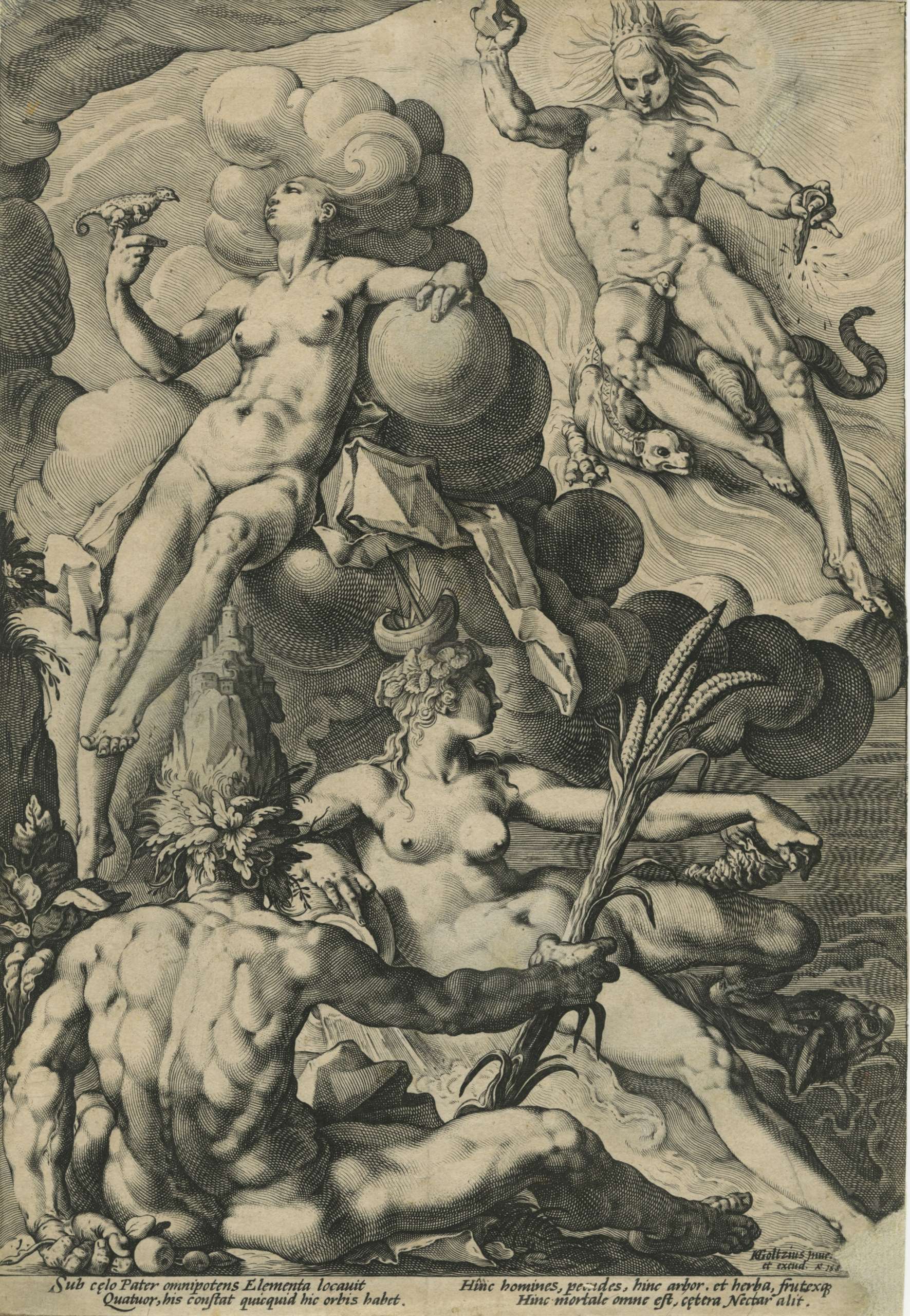
The Four Elements by Jacob Matham (Netherlandish, Haarlem 1571–1631 Haarlem) after Hendrick Goltzius (Netherlandish, Mühlbracht 1558–1617 Haarlem). Engraving on copper, printed on laid paper, 1588.
Dimensions: 298 mm × 206 mm.
-
 The print lacks signature. It is attributed by some to Suzuki Harunobu and by the others to Isoda Koryūsai.
The print lacks signature. It is attributed by some to Suzuki Harunobu and by the others to Isoda Koryūsai.Attributed to Koryūsai: Pins #517/p.209, c. 1775 [AIC II: Clarence Buckingham Collection, 1925.2772], Ukiyo-e Taisei IV; Vignier & Inada, 1911; Ritsumeikan University Z0165-239.
Attributed to Harunobu: Pins #239/p.132.; BM 1906,1220,0.85;
-
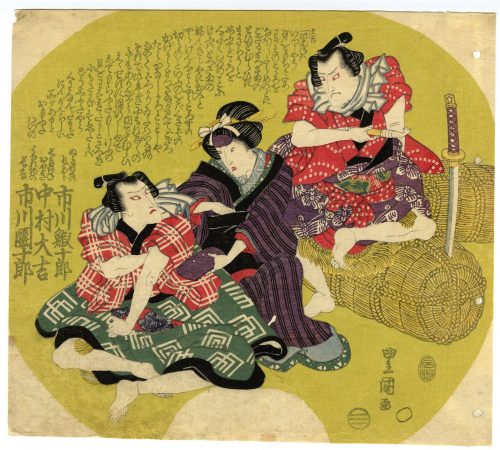 Artist: Utagawa Toyokuni I [歌川豊国] (1769–1825). Publisher: Ibaya Senzaburō [伊場屋 仙三郎] (fl. 1815 – 1869). Signed: Toyokuni ga [豊国 画]. Publisher's seal: Ibaya Sensaburō (Marks 08-067 | 127b). Date-aratame seal: Bunsei 3 (1820). Size: Uncut fan print (uchiwa-e), 224 x 254 mm. Ichikawa Ebijūrō I as Nuregami Chōgorō [濡髪の長五郎], Nakamura Daikichi as Hanaregoma Oseki [放駒のお関], and Ichikawa Danjūrō VII as Hanaregoma Chōkichi [放駒長吉] in a kabuki play Futatsu Chôchô Kuruwa Nikki [双蝶々曲輪日記] (A Diary of Two Butterflies in the Pleasure Quarters (see: LIB-0879.2015 | Brandon, James R., Leiter, Samuel L. Kabuki Plays on Stage: Brilliance and Bravado, 1697-1766 (Volume 1). — Honolulu: University of Hawai'i Press, 2002.) The play was performed at Kawarasakiza (Edo) in May of 1820. Actors: Ichikawa Ebijūrō I [市川鰕十郎] (Japanese, 1777 – 1827); other names: Ichikawa Ichizō I [市川市蔵], Ichinokawa Ichizō [市ノ川市蔵]. Nakamura Daikichi I [初代中村大吉](Japanese, 1773 – 1823); other names: Fujikawa Daikichi [藤川大吉]; poetry name Hajō [巴丈]; pen name Naruo Yatarō [藤川大吉]. Ichikawa Danjūrō VII 市川団十郎 (Japanese, 1791 – 1859); other names: Ichikawa Ebizō V, Ichikawa Hakuen II, Ichikawa Shinnosuke I.
Artist: Utagawa Toyokuni I [歌川豊国] (1769–1825). Publisher: Ibaya Senzaburō [伊場屋 仙三郎] (fl. 1815 – 1869). Signed: Toyokuni ga [豊国 画]. Publisher's seal: Ibaya Sensaburō (Marks 08-067 | 127b). Date-aratame seal: Bunsei 3 (1820). Size: Uncut fan print (uchiwa-e), 224 x 254 mm. Ichikawa Ebijūrō I as Nuregami Chōgorō [濡髪の長五郎], Nakamura Daikichi as Hanaregoma Oseki [放駒のお関], and Ichikawa Danjūrō VII as Hanaregoma Chōkichi [放駒長吉] in a kabuki play Futatsu Chôchô Kuruwa Nikki [双蝶々曲輪日記] (A Diary of Two Butterflies in the Pleasure Quarters (see: LIB-0879.2015 | Brandon, James R., Leiter, Samuel L. Kabuki Plays on Stage: Brilliance and Bravado, 1697-1766 (Volume 1). — Honolulu: University of Hawai'i Press, 2002.) The play was performed at Kawarasakiza (Edo) in May of 1820. Actors: Ichikawa Ebijūrō I [市川鰕十郎] (Japanese, 1777 – 1827); other names: Ichikawa Ichizō I [市川市蔵], Ichinokawa Ichizō [市ノ川市蔵]. Nakamura Daikichi I [初代中村大吉](Japanese, 1773 – 1823); other names: Fujikawa Daikichi [藤川大吉]; poetry name Hajō [巴丈]; pen name Naruo Yatarō [藤川大吉]. Ichikawa Danjūrō VII 市川団十郎 (Japanese, 1791 – 1859); other names: Ichikawa Ebizō V, Ichikawa Hakuen II, Ichikawa Shinnosuke I. -
 Artist: Utagawa Kunisada [歌川 国貞] a.k.a. Utagawa Toyokuni III [三代 歌川 豊国] (Japanese, 1786 – 1865). Signed: Kōchōrō Kunisada ga [香蝶楼国貞画] in a double-gourd cartouche. Iseya Sōemon [伊勢屋惣右衛門] (Japanese, 1776 – 1862); seal: Ue [上] (Marks 02-041 | 156a). Inscription in the red stripe: Five types of haiku in shōfū style [俳諧五流蕉風] (Haikai gōryū shōfū). Censor's seal: Watari [渡] (Watanabe Shōemon), VI/1842–V ic/1846. Media: Fan print [団扇絵] (Uchiwa-e); size: 225 x 292 mm. An uncut fan print depicts a young woman with an insect (firefly) cage in her left hand. Her striped kimono is adorned with the design of white, grey and blue cherry blossoms. Two of the Seven Grasses of Autumn [秋の七草] (aki no nanakusa), namely Platycodon grandiflorus (kikyō) [桔梗] a.k.a. Chinese bellflower (or balloon flower) and Patrinia scabiosifolia (ominaeshi) [女郎花] a. k.a. Eastern (or Golden) Valerian, are seen on her right-hand side.
Artist: Utagawa Kunisada [歌川 国貞] a.k.a. Utagawa Toyokuni III [三代 歌川 豊国] (Japanese, 1786 – 1865). Signed: Kōchōrō Kunisada ga [香蝶楼国貞画] in a double-gourd cartouche. Iseya Sōemon [伊勢屋惣右衛門] (Japanese, 1776 – 1862); seal: Ue [上] (Marks 02-041 | 156a). Inscription in the red stripe: Five types of haiku in shōfū style [俳諧五流蕉風] (Haikai gōryū shōfū). Censor's seal: Watari [渡] (Watanabe Shōemon), VI/1842–V ic/1846. Media: Fan print [団扇絵] (Uchiwa-e); size: 225 x 292 mm. An uncut fan print depicts a young woman with an insect (firefly) cage in her left hand. Her striped kimono is adorned with the design of white, grey and blue cherry blossoms. Two of the Seven Grasses of Autumn [秋の七草] (aki no nanakusa), namely Platycodon grandiflorus (kikyō) [桔梗] a.k.a. Chinese bellflower (or balloon flower) and Patrinia scabiosifolia (ominaeshi) [女郎花] a. k.a. Eastern (or Golden) Valerian, are seen on her right-hand side. -
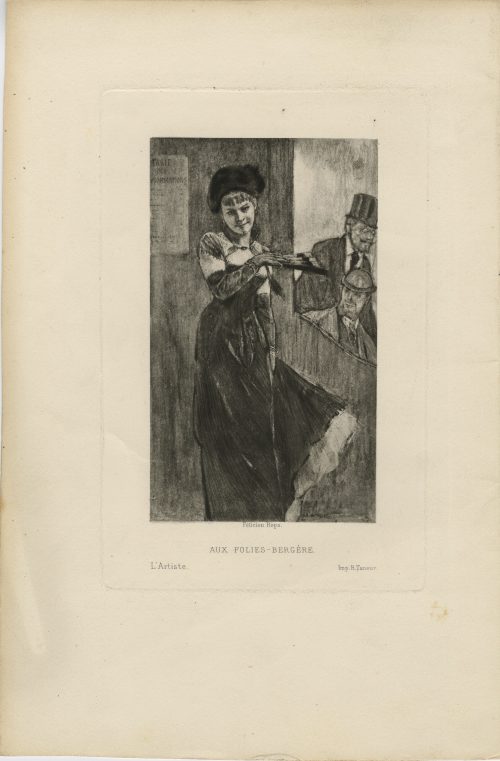
Aquatint finished by a drypoint on wove paper; printed by R. Taneur, depicting young woman in bar Folies Bergère in Paris. Signed in plate under image: "Félicien Rops | AUX FOLIES-BERGÈRE | L'Artiste. — Imp. R. Taneur. Owner's stamp 'LvM' on verso.
Dimensions: Paper: 26.7 x 17.6 cm; Plate: 17.5 x 11.5 cm; Image: 13.5 x 8 cm.
Catalogue raisonné: Graphics irreverent and erotic (1968): 125.
-
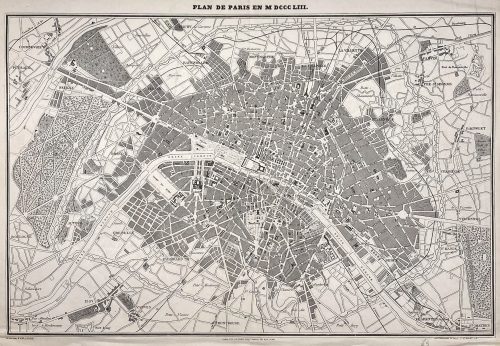 Above the frame: PLAN DE PARIS EN MDCCCLIII. Below the frame: Gravé par F. DELAMARE […] PARIS. TYP. DE FIRMIN DIDOT FRÈRES, 56, RUE JACOB. […] PANICONOGRAPHIE DE GILLOT. Q. ST. MICHEL 23. Dimensions: Sheet: 37 x 52.5 cm: Image: 33 x 50 cm. Technique: Photozincography Contributors: Ferdinand Théodore Delamare (French, fl. 1850 – 1889) – engraver. Firmin Didot Frères ; Firmin Didot (French, 1764 – 1836) – publisher. Firmin Gillot (French, 1819 – 1872) – printer.
Above the frame: PLAN DE PARIS EN MDCCCLIII. Below the frame: Gravé par F. DELAMARE […] PARIS. TYP. DE FIRMIN DIDOT FRÈRES, 56, RUE JACOB. […] PANICONOGRAPHIE DE GILLOT. Q. ST. MICHEL 23. Dimensions: Sheet: 37 x 52.5 cm: Image: 33 x 50 cm. Technique: Photozincography Contributors: Ferdinand Théodore Delamare (French, fl. 1850 – 1889) – engraver. Firmin Didot Frères ; Firmin Didot (French, 1764 – 1836) – publisher. Firmin Gillot (French, 1819 – 1872) – printer. -
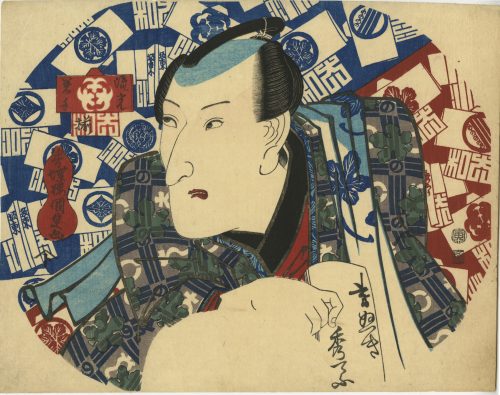 Artist: Utagawa Kunisada [歌川 国貞] a.k.a. Utagawa Toyokuni III [三代歌川豊国] (Japanese, 1786 – 1865). Signed: Kochoro Kuisada ga [香蝶楼国貞画] in a red double-gourd cartouche Publisher: Enshūya Matabei [遠州屋又兵衛] (Japanese, fl. c. 1768 – 1881). Series: Fashionable Youths [流行若手揃] (Ryuko Wakate Zoroi). Actor: Bandō Minosuke II [坂東蓑助] (Japanese, 1802 – 1863); other names: Morita Kan'ya XI, Bandô Mitsugorō IV. Date-kiwame seals: Bunsei 13 / Tenpō 1 (1830). One more print from the same series (See Waseda 201-2125); not in this collection: Segawa Kikunojō V [瀬川菊之丞] (Japanese, 1802 – 1832); other names: Segawa Tamon I.
Artist: Utagawa Kunisada [歌川 国貞] a.k.a. Utagawa Toyokuni III [三代歌川豊国] (Japanese, 1786 – 1865). Signed: Kochoro Kuisada ga [香蝶楼国貞画] in a red double-gourd cartouche Publisher: Enshūya Matabei [遠州屋又兵衛] (Japanese, fl. c. 1768 – 1881). Series: Fashionable Youths [流行若手揃] (Ryuko Wakate Zoroi). Actor: Bandō Minosuke II [坂東蓑助] (Japanese, 1802 – 1863); other names: Morita Kan'ya XI, Bandô Mitsugorō IV. Date-kiwame seals: Bunsei 13 / Tenpō 1 (1830). One more print from the same series (See Waseda 201-2125); not in this collection: Segawa Kikunojō V [瀬川菊之丞] (Japanese, 1802 – 1832); other names: Segawa Tamon I.
-
 Artist: Utagawa Kunisada [歌川 国貞] a.k.a. Utagawa Toyokuni III [三代歌川豊国] (Japanese, 1786 – 1865). Artist signature: By the brush of the 79-year-old Toyokuni [七十九歳豊國画] (Nanajūkyū-sai Toyokuni ga). Publisher: Ebiya Rinnosuke [海老屋林之助] (Japanese, fl. c. 1832 – 1895); seal: ト/ 海老林 (to, Ebirin). Block carver: Matsushima Masakichi [松島政吉]; seal: carved by Masa [彫政] (Hori Masa). Combined date seal and kiwame censor seal: [子極] 1864 (Bunkyū 4/Genji 1). Media: Untrimmed fan print (uchiwa-e), 223 x 297 mm. Inscription in the cartouches: (R) Wakana-hime [若菜姫], Sawamura Tanosuke III [沢村田之助]; (L) Ashikaga Sanshichirō [足利三七郎], Sawamura Tosshō II [沢村訥升]. Play: Kinoene Soga Daikoku-bashira [甲子曽我大国柱], performed at the Morita theatre [森田座・守田座] (Morita-za) in 1864 (Bunkyū 4/Genji 1), 2nd month (see playbill at MFA-Boston Collection). Playwright: Muraoka Kōji II [村岡幸治]. Actors and Characters: Sawamura Tanosuke III [三代目沢村田之助] (Japanese, 1859 – 1878); other names: Shozan [曙山] (poetry name), Sawamura Yoshijirō I [初代沢村由次郎], here in the role of Princess Wakana [若菜姫] (Wakana-hime) (R). The story about Princess Wakana, Shiranui Monogatari, was written by Ryukatei Tanekazu [柳下亭種員] (Japanese, 1807 – 1858) and published as a 90-volume book of comics between 1849 and 1855. ...The tale revolves around the clash between the Kikuchi and Ōtomo clans. Princess Wakana’s father Ōtomo Sōrin [大友 宗麟] (1530 – 1587) was killed in a battle, and his spirit demanded revenge. To appease her late father's spirit, Princes Wakana acquired the power of the Earth Spider. She often appears in prints with a magic scroll, which helps her fight various enemies. Sawamura Tosshō II [二代目沢村訥升] (Japanese, 1854 – 1879); other names: Kōga [高賀] (poetry name), Sawamura Genpei II [二代目沢村源平], Sawamura Sōjūrō [澤村宗十郎], Suketakaya Takasuke IV [四代目助高屋高助], Sawamura Tosshi VI [六代目澤村訥子] (poetry name), here in the role of Ashikaga Sanshichirō [足利三七郎] (L) with a horse. According to Markus Sesko, the scene comes from the kabuki play Umakiri (馬斬り) by Tatsuoka Mansaku [辰岡万作] (17432 – 1809), which premiered in 1794. It was later assimilated into the Kabuki play Kozotte Mimasu Kuruwa no Datezome [襷廓三升伊達染], which was staged in the 1st lunar month of 1853 at the Nakamura-za. Umakiri is based on a Kyōgen play featured in Hideyoshi’s biography Taikōki [太閤記]. Its plot is that Ashikaga Sanchichirō Yoshitaka [足利三七郎義孝・義高], who is supposed to allude to Nobunaga’s son Oda Sanshichirō Nobutaka [織田三七郎信孝], attacks and kills a horse that is carrying 3,000 ryō (金三千両), money Mashiba Hisayoshi [真柴久吉] (an allusion to Hashiba Hideyoshi [羽柴秀吉]) had sent to be donated to a shrine on Mt. Kōya. The surrounding people try to catch him, but when they hear it is Yoshitaka who killed the horse, they fall to the ground and prostrate, and Yoshitaka leisurely leaves with the money. The plot is very simple, but Yoshitaka’s dashing appearance makes it very pleasing to watch. There are also prints that quote the main protagonist as Ashikaga Sanshichirō Harutaka [足利三七郎春高], and there is another title for the play, Sanzen-Ryō Kogane no Kurairi [三千両黄金蔵入] (Pocketing 3,000 ryō of gold). For reference, see also the BLOG. What these two characters are doing in one play remains a riddle. As Mr Graebner comments: "Most kabuki plays were only performed for one season (two months), and the books were lost. The playwrights have repeatedly used parts of plots from other plays, they have adopted characters, sometimes with the same or similar names. What can be found is the Kabuki Playbill (Tsuji banzuke) with cast and roles; the content is lost". Acknowledgements: Special thanks to Horst Graebner of the Kunisada Project and to Markus Sesko of The Metropolitan Museum, NY, for the analysis of the image and their invaluable contribution. For reference, see also:
Artist: Utagawa Kunisada [歌川 国貞] a.k.a. Utagawa Toyokuni III [三代歌川豊国] (Japanese, 1786 – 1865). Artist signature: By the brush of the 79-year-old Toyokuni [七十九歳豊國画] (Nanajūkyū-sai Toyokuni ga). Publisher: Ebiya Rinnosuke [海老屋林之助] (Japanese, fl. c. 1832 – 1895); seal: ト/ 海老林 (to, Ebirin). Block carver: Matsushima Masakichi [松島政吉]; seal: carved by Masa [彫政] (Hori Masa). Combined date seal and kiwame censor seal: [子極] 1864 (Bunkyū 4/Genji 1). Media: Untrimmed fan print (uchiwa-e), 223 x 297 mm. Inscription in the cartouches: (R) Wakana-hime [若菜姫], Sawamura Tanosuke III [沢村田之助]; (L) Ashikaga Sanshichirō [足利三七郎], Sawamura Tosshō II [沢村訥升]. Play: Kinoene Soga Daikoku-bashira [甲子曽我大国柱], performed at the Morita theatre [森田座・守田座] (Morita-za) in 1864 (Bunkyū 4/Genji 1), 2nd month (see playbill at MFA-Boston Collection). Playwright: Muraoka Kōji II [村岡幸治]. Actors and Characters: Sawamura Tanosuke III [三代目沢村田之助] (Japanese, 1859 – 1878); other names: Shozan [曙山] (poetry name), Sawamura Yoshijirō I [初代沢村由次郎], here in the role of Princess Wakana [若菜姫] (Wakana-hime) (R). The story about Princess Wakana, Shiranui Monogatari, was written by Ryukatei Tanekazu [柳下亭種員] (Japanese, 1807 – 1858) and published as a 90-volume book of comics between 1849 and 1855. ...The tale revolves around the clash between the Kikuchi and Ōtomo clans. Princess Wakana’s father Ōtomo Sōrin [大友 宗麟] (1530 – 1587) was killed in a battle, and his spirit demanded revenge. To appease her late father's spirit, Princes Wakana acquired the power of the Earth Spider. She often appears in prints with a magic scroll, which helps her fight various enemies. Sawamura Tosshō II [二代目沢村訥升] (Japanese, 1854 – 1879); other names: Kōga [高賀] (poetry name), Sawamura Genpei II [二代目沢村源平], Sawamura Sōjūrō [澤村宗十郎], Suketakaya Takasuke IV [四代目助高屋高助], Sawamura Tosshi VI [六代目澤村訥子] (poetry name), here in the role of Ashikaga Sanshichirō [足利三七郎] (L) with a horse. According to Markus Sesko, the scene comes from the kabuki play Umakiri (馬斬り) by Tatsuoka Mansaku [辰岡万作] (17432 – 1809), which premiered in 1794. It was later assimilated into the Kabuki play Kozotte Mimasu Kuruwa no Datezome [襷廓三升伊達染], which was staged in the 1st lunar month of 1853 at the Nakamura-za. Umakiri is based on a Kyōgen play featured in Hideyoshi’s biography Taikōki [太閤記]. Its plot is that Ashikaga Sanchichirō Yoshitaka [足利三七郎義孝・義高], who is supposed to allude to Nobunaga’s son Oda Sanshichirō Nobutaka [織田三七郎信孝], attacks and kills a horse that is carrying 3,000 ryō (金三千両), money Mashiba Hisayoshi [真柴久吉] (an allusion to Hashiba Hideyoshi [羽柴秀吉]) had sent to be donated to a shrine on Mt. Kōya. The surrounding people try to catch him, but when they hear it is Yoshitaka who killed the horse, they fall to the ground and prostrate, and Yoshitaka leisurely leaves with the money. The plot is very simple, but Yoshitaka’s dashing appearance makes it very pleasing to watch. There are also prints that quote the main protagonist as Ashikaga Sanshichirō Harutaka [足利三七郎春高], and there is another title for the play, Sanzen-Ryō Kogane no Kurairi [三千両黄金蔵入] (Pocketing 3,000 ryō of gold). For reference, see also the BLOG. What these two characters are doing in one play remains a riddle. As Mr Graebner comments: "Most kabuki plays were only performed for one season (two months), and the books were lost. The playwrights have repeatedly used parts of plots from other plays, they have adopted characters, sometimes with the same or similar names. What can be found is the Kabuki Playbill (Tsuji banzuke) with cast and roles; the content is lost". Acknowledgements: Special thanks to Horst Graebner of the Kunisada Project and to Markus Sesko of The Metropolitan Museum, NY, for the analysis of the image and their invaluable contribution. For reference, see also: -
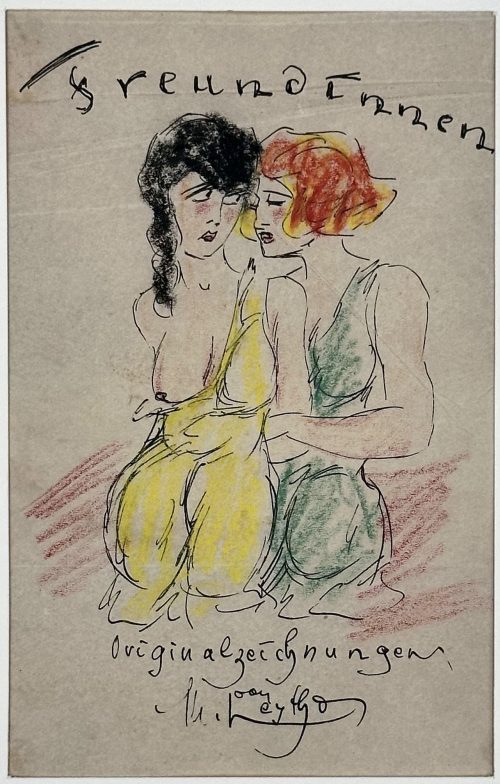 Seven pen and ink and colour crayon drawings on thin wove paper approx. 140 x 100 mm, each attached to a sheet 310 x 240 mm and mounted in a passepartout, placed in an aubergine cardboard folder 310 x 250 mm with a tan vellum spine and paper flaps inside; olive label with double border and gilt lettering to front cover "Dessins" [Drawings]. The first sheet is a title-page lettered in manuscript: Freundinnen | {vignette} | Originalzeichnungen | M. Leytho || [Girlfriends. Original drawings]. Information about the artist at www.honesterotica.com: "Mitja Leytho, almost certainly a pseudonym, is yet another mediocre yet fascinating amateur artist from the Germany of the 1920s about whom we know absolutely nothing beyond the four portfolios which bear the ‘Leytho’ signature". We shall notice that this set of drawings was produced by a talented professional, not an amateur.
Seven pen and ink and colour crayon drawings on thin wove paper approx. 140 x 100 mm, each attached to a sheet 310 x 240 mm and mounted in a passepartout, placed in an aubergine cardboard folder 310 x 250 mm with a tan vellum spine and paper flaps inside; olive label with double border and gilt lettering to front cover "Dessins" [Drawings]. The first sheet is a title-page lettered in manuscript: Freundinnen | {vignette} | Originalzeichnungen | M. Leytho || [Girlfriends. Original drawings]. Information about the artist at www.honesterotica.com: "Mitja Leytho, almost certainly a pseudonym, is yet another mediocre yet fascinating amateur artist from the Germany of the 1920s about whom we know absolutely nothing beyond the four portfolios which bear the ‘Leytho’ signature". We shall notice that this set of drawings was produced by a talented professional, not an amateur. -
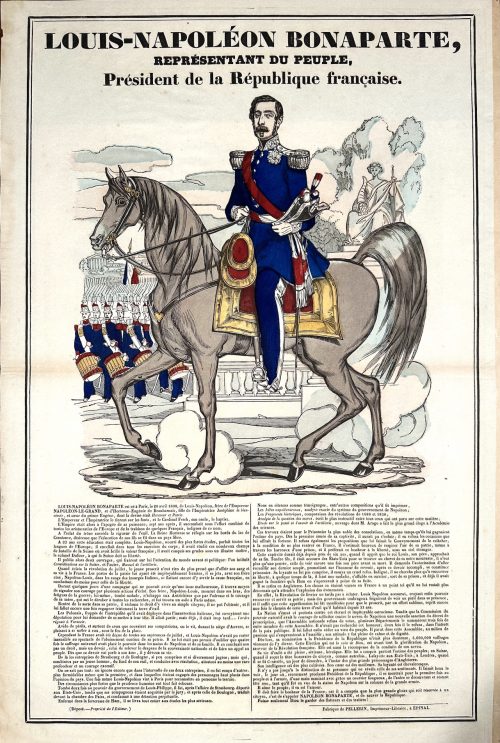 Hand-coloured woodcut poster on wove paper, 622 x 417 mm; black ink stamp “4859” to reverse, horizontal centrefold. In a double frame, top: LOUIS-NAPOLÉON BONAPARTE, | REPRÉSENTANT DU PEUPLE, | Président de la République française. Text under the image ; bottom left: (Déposé.— Propriété de l’Éditeur.); right: Fabrique de PELLERIN, Imprimeur-Libraire, à ÉPINAL. Jean Charles Pellerin (French, 1756 – 1836) – printer/publisher.
Hand-coloured woodcut poster on wove paper, 622 x 417 mm; black ink stamp “4859” to reverse, horizontal centrefold. In a double frame, top: LOUIS-NAPOLÉON BONAPARTE, | REPRÉSENTANT DU PEUPLE, | Président de la République française. Text under the image ; bottom left: (Déposé.— Propriété de l’Éditeur.); right: Fabrique de PELLERIN, Imprimeur-Libraire, à ÉPINAL. Jean Charles Pellerin (French, 1756 – 1836) – printer/publisher. -
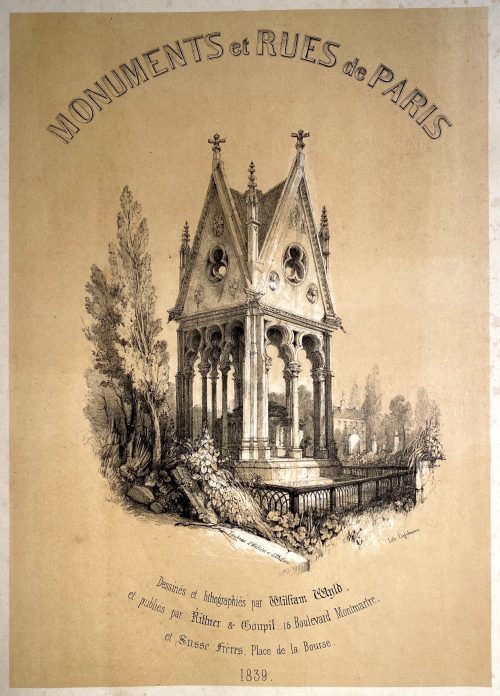 Pictorial album 55.5 x 41.0 cm, publisher’s quarter sheepskin over cloth, upper cover and flat spine lettered in gilt. Title: MONUMENTS et RUES de PARIS | Dessinés et lithographiés par William Wyld, | et publiés par Rittner & Goupil, 15 Boulevard Montmartre, | et Susse Frères, Place de la Bourse. | 1839. Collation: Title plate + 20 plates numbered from 1 to 20, printed by Godefroy Engelmann (French, 1788 – 1839) in tone lithography after drawings by William Wyld (British, 1806 – 1889). Published in Paris by Rittner & Goupil and Susse Frères in 1839. Plates: 54.8 x 39.8 cm. Contents:
Pictorial album 55.5 x 41.0 cm, publisher’s quarter sheepskin over cloth, upper cover and flat spine lettered in gilt. Title: MONUMENTS et RUES de PARIS | Dessinés et lithographiés par William Wyld, | et publiés par Rittner & Goupil, 15 Boulevard Montmartre, | et Susse Frères, Place de la Bourse. | 1839. Collation: Title plate + 20 plates numbered from 1 to 20, printed by Godefroy Engelmann (French, 1788 – 1839) in tone lithography after drawings by William Wyld (British, 1806 – 1889). Published in Paris by Rittner & Goupil and Susse Frères in 1839. Plates: 54.8 x 39.8 cm. Contents:Title page: Tombeau d'Heloïse et d'Abélard
- Le Pont Neuf
- L'église de la Madeleine
- La Porte St. Martin
- Palais des Tuileries
- Pont des Saints-Pères
- Hôtel de Ville
- Marché des Innocents
- Palais Royal
- Boulevard des Italiens
- Rue de la Paix
- Bourse et Tribunal de Commerce
- Porte St. Denis
- Pont Royal
- Place de la Concorde
- Paris from Père Lachaise
- Notre-Dame
- Jardin des Tuileries with Arc de Triomphe in the Distance
- Panthéon
- Chambre des députés
- Arc de Triomphe de l'Étoile
-
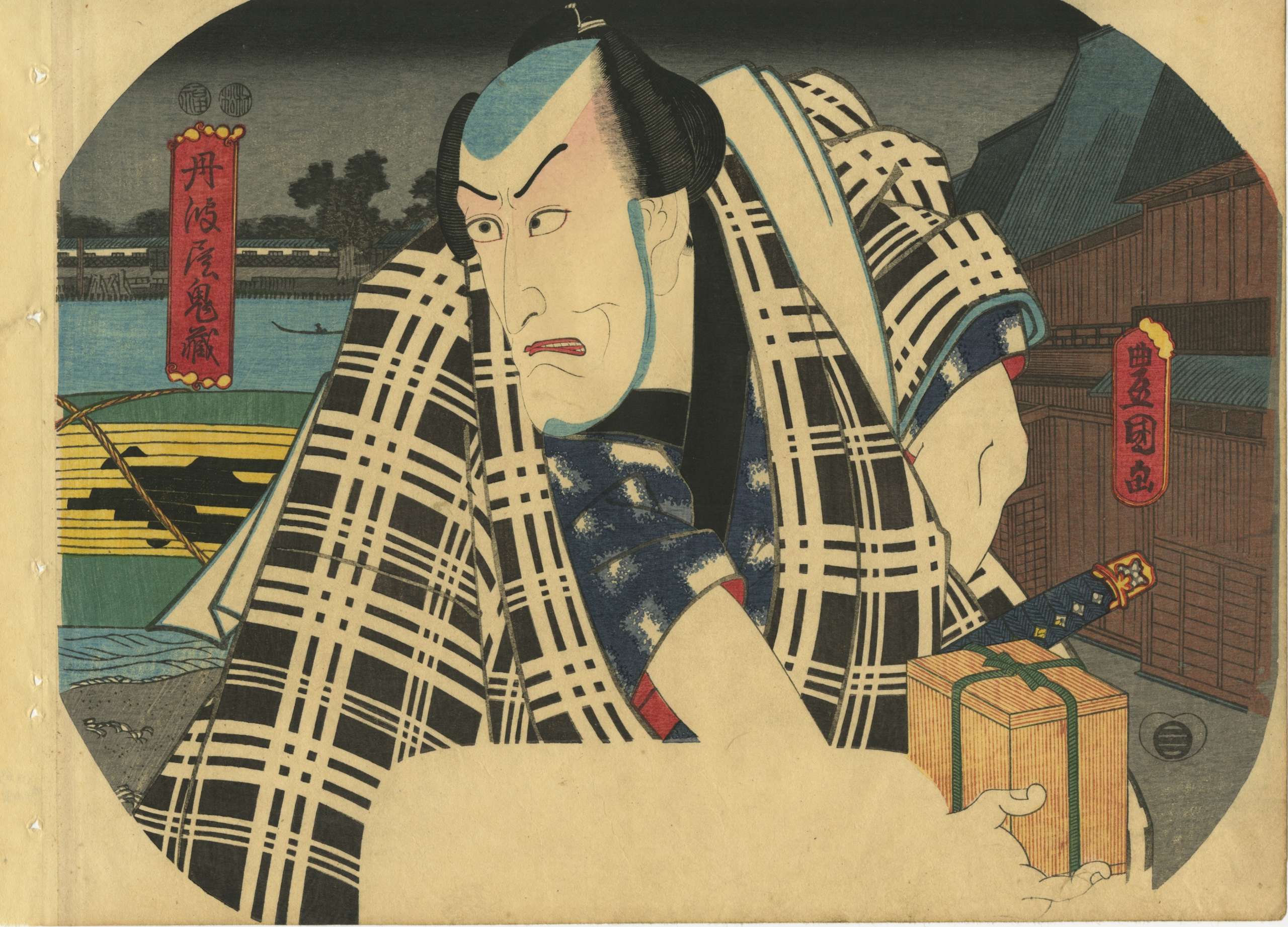 Artist: Utagawa Kunisada [歌川 国貞] a.k.a. Utagawa Toyokuni III [三代歌川豊国] (Japanese, 1786 – 1865). Signed: Toyokuni ga [豊国 画] in a red toshidama cartouche. Actor: Ichikawa Danjūrō VII 市川団十郎 (Japanese, 1791 – 1859); other names: Ichikawa Ebizō V, Ichikawa Hakuen II, Ichikawa Shinnosuke I. Character: Tanbaya Onizo [丹波屋鬼蔵] Play: Koi Bikyaku Yamato Orai [恋飛脚大和往来] Performance: Kawarasaki Theatre [河原崎座] in the 2nd month of 1851. Double nanushi censor seals: Fuku & Muramatsu, from 3rd month of Kaei 2 to 11th month of Kaei 4 (1849-51). Another fan print from the pair SVJP-0212-2.2016: Sawamura Chōjūrō V as Kameya Chubei.
Artist: Utagawa Kunisada [歌川 国貞] a.k.a. Utagawa Toyokuni III [三代歌川豊国] (Japanese, 1786 – 1865). Signed: Toyokuni ga [豊国 画] in a red toshidama cartouche. Actor: Ichikawa Danjūrō VII 市川団十郎 (Japanese, 1791 – 1859); other names: Ichikawa Ebizō V, Ichikawa Hakuen II, Ichikawa Shinnosuke I. Character: Tanbaya Onizo [丹波屋鬼蔵] Play: Koi Bikyaku Yamato Orai [恋飛脚大和往来] Performance: Kawarasaki Theatre [河原崎座] in the 2nd month of 1851. Double nanushi censor seals: Fuku & Muramatsu, from 3rd month of Kaei 2 to 11th month of Kaei 4 (1849-51). Another fan print from the pair SVJP-0212-2.2016: Sawamura Chōjūrō V as Kameya Chubei.
-
 Kitagawa Utamaro. Illustration from the book Ehon koi no Onamaki. Cited at Hayashi Yoshikazu's 20-volume set Edo makura-e shi shusei: Kitagawa Utamaro. Size: Chuban (25.5 x 18.5 cm), two book pages glued together.
Kitagawa Utamaro. Illustration from the book Ehon koi no Onamaki. Cited at Hayashi Yoshikazu's 20-volume set Edo makura-e shi shusei: Kitagawa Utamaro. Size: Chuban (25.5 x 18.5 cm), two book pages glued together. -
 Le Petit Chaperon rouge (Little Red Riding Hood), three wood engravings by Gustave Doré, 1864: "En passant dans un bois elle rencontra compère le Loup"; "Le Chaperon rouge fut bien étonné de voir comment sa grand'mère était faite en son déshabillé"; "Cela n'empêche pas qu'avec ses gran dents il avait mangé une bonne grand'mère". Engraved by Adolphe Pannemaker. Le Petit Poucet (Little Thumb), one wood engraving by Gustave Doré, 1864: "Une bonne femme vint leur ouvrir". Engraved by Héliodore-Joseph Pisan. La Belle au bois dormant (Sleeping Beauty), one wood engraving by Gustave Doré, 1864: "Il marcha vers le château qu'il voyait au bout d'une grande avenue où il entra". Engraved by Héliodore-Joseph Pisan. Medium: Paper; Wood engraving. Illustrations for P.-J. Hetzel's edition of Perrault's Fairy Tales (Les Contes de Perrault) by Gustave Doré published in 1864. Size: frame: 428 x 302 mm; sheet: 280 x 231 mm; image: 194 x 244 mm.
Le Petit Chaperon rouge (Little Red Riding Hood), three wood engravings by Gustave Doré, 1864: "En passant dans un bois elle rencontra compère le Loup"; "Le Chaperon rouge fut bien étonné de voir comment sa grand'mère était faite en son déshabillé"; "Cela n'empêche pas qu'avec ses gran dents il avait mangé une bonne grand'mère". Engraved by Adolphe Pannemaker. Le Petit Poucet (Little Thumb), one wood engraving by Gustave Doré, 1864: "Une bonne femme vint leur ouvrir". Engraved by Héliodore-Joseph Pisan. La Belle au bois dormant (Sleeping Beauty), one wood engraving by Gustave Doré, 1864: "Il marcha vers le château qu'il voyait au bout d'une grande avenue où il entra". Engraved by Héliodore-Joseph Pisan. Medium: Paper; Wood engraving. Illustrations for P.-J. Hetzel's edition of Perrault's Fairy Tales (Les Contes de Perrault) by Gustave Doré published in 1864. Size: frame: 428 x 302 mm; sheet: 280 x 231 mm; image: 194 x 244 mm. -
 Artist: Utagawa Kuniyoshi [歌川 國芳] (Japanese, 1798 – 1861). Publisher: Ibaya Senzaburō [伊場屋仙三郎] (Japanese, c. 1815 – 1869). Published in c. 1845 (no seal). Possibly, from the "Untitled series of beauties reflected in mirrors", see Kunisada Project. However, this print does not have the seal of the censor Tanaka [田中].
Artist: Utagawa Kuniyoshi [歌川 國芳] (Japanese, 1798 – 1861). Publisher: Ibaya Senzaburō [伊場屋仙三郎] (Japanese, c. 1815 – 1869). Published in c. 1845 (no seal). Possibly, from the "Untitled series of beauties reflected in mirrors", see Kunisada Project. However, this print does not have the seal of the censor Tanaka [田中]. -
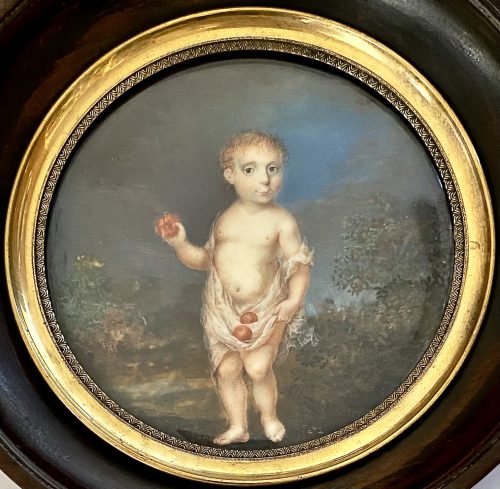 Round portrait of a little girl (22-month-old) with bright black eyes and red hair, draped in a semi-transparent shirt which leaves her chest and stomach bare, keeping a red apple in her right hand and two others lying in the fold of her clothes, standing against a dark natural background: bushes, leaves, an apple tree, blue skies, clouds, etc. Oil on metal; in an ormolu frame, in a wooden frame. Diameter without frames 8 cm, with frames – 12.6 cm. Sitter: Courtois, Fortunée-Florentine Elisabeth (French, August 23, 1800 г. – after 1878). Inscription (handwriting, nut ink): Fortunée, Florentine Elisabeth | Courtois a 22 mois. | née 5e fructidor an 8 || Attributed to Lié Louis Périn-Salbreux (French, 1753 – 1817). Fortunée-Florentine Elisabeth Courtois is a mother of Maurice Joly (French, 1829 – 1878). See also in this collection: blog, LIB-0460, blog, LIB-1038.2016, and Une Épave de l’Ancien Bateau by Tout-Paris. A Lost Article by Proust? The portrait was sold at Drouot (Paris) in 2020 with the following description: "École FRANÇAISE de la fin du XVIIIe siècle Fortunée Florentine Courtois enfant en chemise, en pied dans la nature, tenant trois pommes. Miniature sur ivoire, identifiée au revers : « Florentine Fortunée Elisabeth / Courtois à 22 mois / le 5e ( ?) Fructidor an VIII » [août 1800]; Diam. à vue : 7 cm; Cadre rond en bois tourné et noirci. Florentine Courtois, fille d’André et d’Elisabeth Corbara, épousa vers 1818 Lambert Philippe Joly, conseiller général du Jura, avocat ; leur fils Maurice Joly, avocat, fut ministre de la Justice du gouvernement provisoire en 1870 et grand maître du Grand Orient de France". Maurice Joly was a lawyer, but nothing else in his description given by Drouot is true. From this inscription, we learned that Fortunée-Florentine Elisabeth Courtois was born on August 23, 1800. We were unable to verify this from any other source. From Morice Joly autobiography (Maurice Joly, son passé, son programme par lui-même. — Paris, Lacroix, Verbœckoven et Ce, 1870) we know that she was born in Bastia and that her father, Laurent Courtois (in some sources André François Désiré Courtois, born c. 1771), was a treasurer of Corsican troops under Napoleon Bonapart. Her mother was Elisabeth Marie-Grâcieuse Corbara (born c. 1750).
Round portrait of a little girl (22-month-old) with bright black eyes and red hair, draped in a semi-transparent shirt which leaves her chest and stomach bare, keeping a red apple in her right hand and two others lying in the fold of her clothes, standing against a dark natural background: bushes, leaves, an apple tree, blue skies, clouds, etc. Oil on metal; in an ormolu frame, in a wooden frame. Diameter without frames 8 cm, with frames – 12.6 cm. Sitter: Courtois, Fortunée-Florentine Elisabeth (French, August 23, 1800 г. – after 1878). Inscription (handwriting, nut ink): Fortunée, Florentine Elisabeth | Courtois a 22 mois. | née 5e fructidor an 8 || Attributed to Lié Louis Périn-Salbreux (French, 1753 – 1817). Fortunée-Florentine Elisabeth Courtois is a mother of Maurice Joly (French, 1829 – 1878). See also in this collection: blog, LIB-0460, blog, LIB-1038.2016, and Une Épave de l’Ancien Bateau by Tout-Paris. A Lost Article by Proust? The portrait was sold at Drouot (Paris) in 2020 with the following description: "École FRANÇAISE de la fin du XVIIIe siècle Fortunée Florentine Courtois enfant en chemise, en pied dans la nature, tenant trois pommes. Miniature sur ivoire, identifiée au revers : « Florentine Fortunée Elisabeth / Courtois à 22 mois / le 5e ( ?) Fructidor an VIII » [août 1800]; Diam. à vue : 7 cm; Cadre rond en bois tourné et noirci. Florentine Courtois, fille d’André et d’Elisabeth Corbara, épousa vers 1818 Lambert Philippe Joly, conseiller général du Jura, avocat ; leur fils Maurice Joly, avocat, fut ministre de la Justice du gouvernement provisoire en 1870 et grand maître du Grand Orient de France". Maurice Joly was a lawyer, but nothing else in his description given by Drouot is true. From this inscription, we learned that Fortunée-Florentine Elisabeth Courtois was born on August 23, 1800. We were unable to verify this from any other source. From Morice Joly autobiography (Maurice Joly, son passé, son programme par lui-même. — Paris, Lacroix, Verbœckoven et Ce, 1870) we know that she was born in Bastia and that her father, Laurent Courtois (in some sources André François Désiré Courtois, born c. 1771), was a treasurer of Corsican troops under Napoleon Bonapart. Her mother was Elisabeth Marie-Grâcieuse Corbara (born c. 1750). -
 One of 64 wood engravings by Robert Dill after Joseph Kuhn-Régnier (French, 1873 – 1940), stencil-coloured (au pochoir technique) by Ateliers Jacomet in Paris for the 4-volume edition of Littré’s “Œuvres complètes d'Hippocrate” by Javal & Bourdeaux in 1932-34. The edition was limited to 2,335 numbered copies, 2,000 of them on Vélin teinté du Marais paper., numbered from 336 to 2,335. Contributors: Joseph Kuhn-Régnier (French, 1873 – 1940) – artist. Robert Dill – engraver. Atelier Jacomet (Paris); Daniel Jacomet (French, 1894 – 1966) – printer. Les éditions Javal & Bourdeaux (Paris) – publisher. Émile Littré (French, 1801 – 1881) – translator/ editor. Hippocrates (Greek, c. 460 – c. 370 BC) – author.
One of 64 wood engravings by Robert Dill after Joseph Kuhn-Régnier (French, 1873 – 1940), stencil-coloured (au pochoir technique) by Ateliers Jacomet in Paris for the 4-volume edition of Littré’s “Œuvres complètes d'Hippocrate” by Javal & Bourdeaux in 1932-34. The edition was limited to 2,335 numbered copies, 2,000 of them on Vélin teinté du Marais paper., numbered from 336 to 2,335. Contributors: Joseph Kuhn-Régnier (French, 1873 – 1940) – artist. Robert Dill – engraver. Atelier Jacomet (Paris); Daniel Jacomet (French, 1894 – 1966) – printer. Les éditions Javal & Bourdeaux (Paris) – publisher. Émile Littré (French, 1801 – 1881) – translator/ editor. Hippocrates (Greek, c. 460 – c. 370 BC) – author. -
 Title: Fourth lunar month [卯月] (Uzuki no zu); Series: Fashionable Twelve Months (Imayo juni-kagetsu). Another version of translation: Modern Beauties of Twelve Months. Artist: Utagawa Toyokuni I [歌川豊国] (1769–1825). Pubisher: Ibaya Senzaburō [伊場屋仙三郎] (Japanese, 1815 – 1869), seal: Dansendō [伊場仙]. Signed: Toyokuni ga and sealed with toshidama. Date-kiwame seal: Ushi (ox), Bunsei 5 (1822). Size: double-sheet uncut fan print ( aiban uchiwa-e), 219 x 295 mm.
Title: Fourth lunar month [卯月] (Uzuki no zu); Series: Fashionable Twelve Months (Imayo juni-kagetsu). Another version of translation: Modern Beauties of Twelve Months. Artist: Utagawa Toyokuni I [歌川豊国] (1769–1825). Pubisher: Ibaya Senzaburō [伊場屋仙三郎] (Japanese, 1815 – 1869), seal: Dansendō [伊場仙]. Signed: Toyokuni ga and sealed with toshidama. Date-kiwame seal: Ushi (ox), Bunsei 5 (1822). Size: double-sheet uncut fan print ( aiban uchiwa-e), 219 x 295 mm.

-
 Artist: Utagawa Kunisada [歌川 国貞] a.k.a. Utagawa Toyokuni III [三代歌川豊国] (Japanese, 1786 – 1865). Signed: Ichiyōsai Toyokuni hitsu [一陽斎豊国筆]. Inscriptions: [松竹梅] Shochikubai = pine (matsu, 松), bamboo (take, 竹), and plum (ume, 梅) – an auspicious grouping known as “The Three Friends of Winter“; [三福追] (Sanpuku tsui) – the three delights, or pleasures. Date seal and aratame censor seal: Ansei 2, 1st month (1855). Publisher: Ibaya Senzaburō [伊場屋仙三郎] (Japanese, c. 1815 – 1869). Block carver: Yokokawa Takejirō [横川竹二郎] (Japanese, fl. 1845 – 1863); seal: Hori Take [彫竹]. Kabuki actor Onoe Kikugorō V [五代目尾上菊五郎] (Onoe Baikō V, Ichimura Kakitsu IV, Ichimura Uzaemon XIII, Ichimura Kurōemon, Japanese, 1844 – 1903) giving candies to the memorial portrait of his predecessor, Ichimura Takenojō V [市村竹之丞] (Ichimura Uzaemon XII, Ichimura Kamenosuke, Ichimura Toyomatsu, Japanese, 1812 – 1851); the latter is dressed in a green robe adorned with a crest (mon) of a kōrin-style crane in a tortoiseshell (octagon), the hanging scroll border decorated with bamboo under snow; the collar of Onoe's kimono decorated with plum blossoms, another plum blossom arrangement decorates the screen behind him. Actors identified by Horst Graebner. Two fan prints from this series in Varshavsky Collection:
Artist: Utagawa Kunisada [歌川 国貞] a.k.a. Utagawa Toyokuni III [三代歌川豊国] (Japanese, 1786 – 1865). Signed: Ichiyōsai Toyokuni hitsu [一陽斎豊国筆]. Inscriptions: [松竹梅] Shochikubai = pine (matsu, 松), bamboo (take, 竹), and plum (ume, 梅) – an auspicious grouping known as “The Three Friends of Winter“; [三福追] (Sanpuku tsui) – the three delights, or pleasures. Date seal and aratame censor seal: Ansei 2, 1st month (1855). Publisher: Ibaya Senzaburō [伊場屋仙三郎] (Japanese, c. 1815 – 1869). Block carver: Yokokawa Takejirō [横川竹二郎] (Japanese, fl. 1845 – 1863); seal: Hori Take [彫竹]. Kabuki actor Onoe Kikugorō V [五代目尾上菊五郎] (Onoe Baikō V, Ichimura Kakitsu IV, Ichimura Uzaemon XIII, Ichimura Kurōemon, Japanese, 1844 – 1903) giving candies to the memorial portrait of his predecessor, Ichimura Takenojō V [市村竹之丞] (Ichimura Uzaemon XII, Ichimura Kamenosuke, Ichimura Toyomatsu, Japanese, 1812 – 1851); the latter is dressed in a green robe adorned with a crest (mon) of a kōrin-style crane in a tortoiseshell (octagon), the hanging scroll border decorated with bamboo under snow; the collar of Onoe's kimono decorated with plum blossoms, another plum blossom arrangement decorates the screen behind him. Actors identified by Horst Graebner. Two fan prints from this series in Varshavsky Collection:
SVJP-0335.2021
-
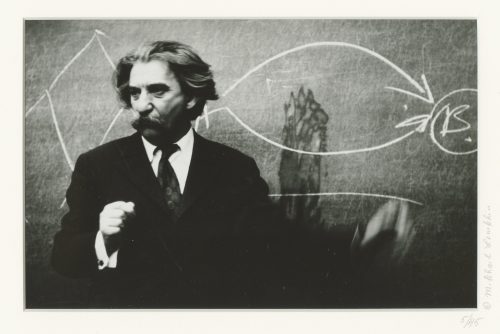 Photographic half-length portrait of academician Juri Lotman, with his head turned to the left, giving a lecture in front of a blackboard. Pencil-signed on the mat: 5/45 • ©Mikhail Lemkhin; on the back of the print: ink stamp ©MIKHAIL LEMKHIN, pencil inscription Mikhail Lemkhin 5/45; ink stamp: PHOTO BY MIKHAIL LEMKHIN | 1811–38th AVENUE | SAN FRANCISCO, CA 94122 | (415) 664-7677; Copyright statement ink stamp; on the back of the mat: pencil inscription (top) ЛОТМАН, ЮРИЙ | YURI LOTMAN, (bottom) VI. Size: mat: 35.6 x 43.1 cm; window: 15.5 x 24 cm; print: 20.2 x 25.3 cm. Limited edition of 45, of which this is № 5, signed and stamped by the artist. Sitter: Juri Lotman [Юрий Михайлович Лотман] (Estonian-Jewish, 1922 – 1993).
Photographic half-length portrait of academician Juri Lotman, with his head turned to the left, giving a lecture in front of a blackboard. Pencil-signed on the mat: 5/45 • ©Mikhail Lemkhin; on the back of the print: ink stamp ©MIKHAIL LEMKHIN, pencil inscription Mikhail Lemkhin 5/45; ink stamp: PHOTO BY MIKHAIL LEMKHIN | 1811–38th AVENUE | SAN FRANCISCO, CA 94122 | (415) 664-7677; Copyright statement ink stamp; on the back of the mat: pencil inscription (top) ЛОТМАН, ЮРИЙ | YURI LOTMAN, (bottom) VI. Size: mat: 35.6 x 43.1 cm; window: 15.5 x 24 cm; print: 20.2 x 25.3 cm. Limited edition of 45, of which this is № 5, signed and stamped by the artist. Sitter: Juri Lotman [Юрий Михайлович Лотман] (Estonian-Jewish, 1922 – 1993). -
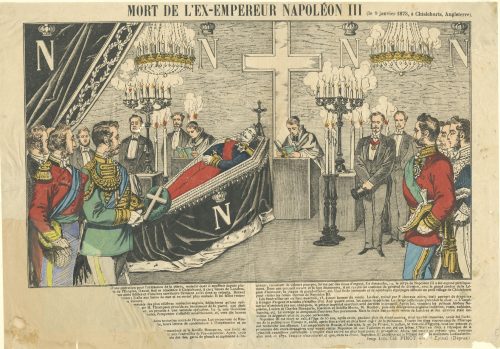 Hand-coloured woodcut on wove paper, 270 x 380 mm; attached to the sheet 303 x 442 mm with pencil ms inscription to the top left corner on the reverse: “Haye le 2-3-75”. Top: "MORT DE L'EX-EMPEREUR NAPOLÉON III (le 9 janvier 1873, à Chislehurts [sic], Angleterre)." Bottom right: "Imp. Lith. CH. PINOT, éditeur. Épinal (Dépose)". Bottom left corner of the image sheet torn and manually restored. Text partially lost, starting with « d’une opération pour l’extraction de la pierre, maladie dont’ il souffrait depuis plu-… ». See Chislehurst. Charles-François Pinot (French, 1817 – 1879) – publisher/printer.
Hand-coloured woodcut on wove paper, 270 x 380 mm; attached to the sheet 303 x 442 mm with pencil ms inscription to the top left corner on the reverse: “Haye le 2-3-75”. Top: "MORT DE L'EX-EMPEREUR NAPOLÉON III (le 9 janvier 1873, à Chislehurts [sic], Angleterre)." Bottom right: "Imp. Lith. CH. PINOT, éditeur. Épinal (Dépose)". Bottom left corner of the image sheet torn and manually restored. Text partially lost, starting with « d’une opération pour l’extraction de la pierre, maladie dont’ il souffrait depuis plu-… ». See Chislehurst. Charles-François Pinot (French, 1817 – 1879) – publisher/printer. -
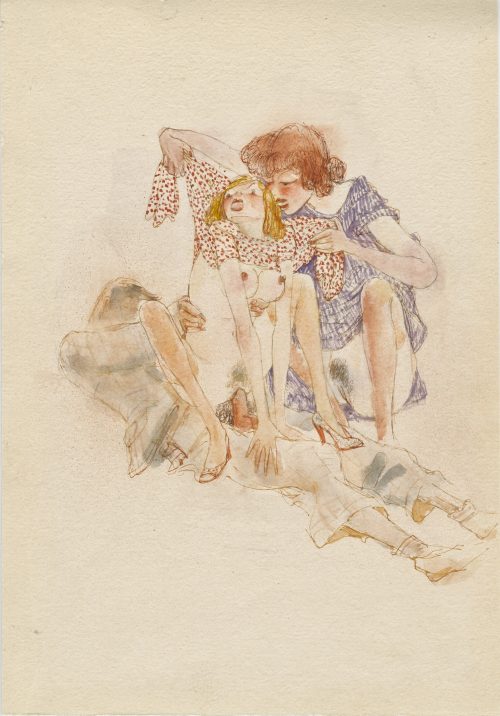 Watercolour on thick wove paper, unsigned. Attributed to Otto Rudolf Schatz (Austrian, 1900 – 1961). Size: 305 x 212 mm.
Watercolour on thick wove paper, unsigned. Attributed to Otto Rudolf Schatz (Austrian, 1900 – 1961). Size: 305 x 212 mm. -
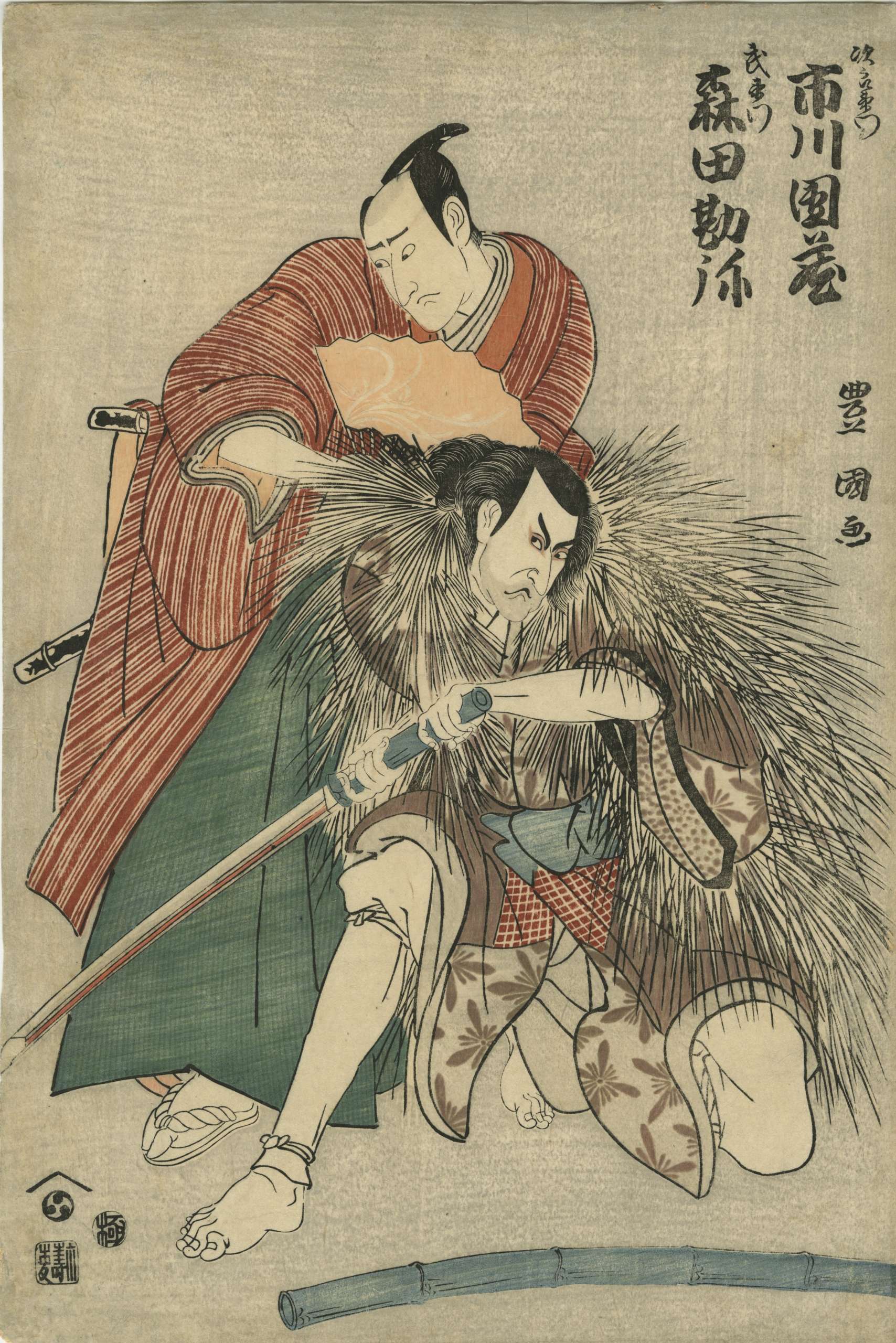 Utagawa Toyokuni (歌川豐國); 1769 – 24 February 1825. The kabuki actors Ichikawa Danzo IV as Jiroemon (in draw cape) and Morita Kanya VIII as Buemon. Play 'Oriai Tsuzure no Nishiki', performed at the Moritaza Theater in the 7th month of 1798. Publisher: Eijudo.
Utagawa Toyokuni (歌川豐國); 1769 – 24 February 1825. The kabuki actors Ichikawa Danzo IV as Jiroemon (in draw cape) and Morita Kanya VIII as Buemon. Play 'Oriai Tsuzure no Nishiki', performed at the Moritaza Theater in the 7th month of 1798. Publisher: Eijudo. -
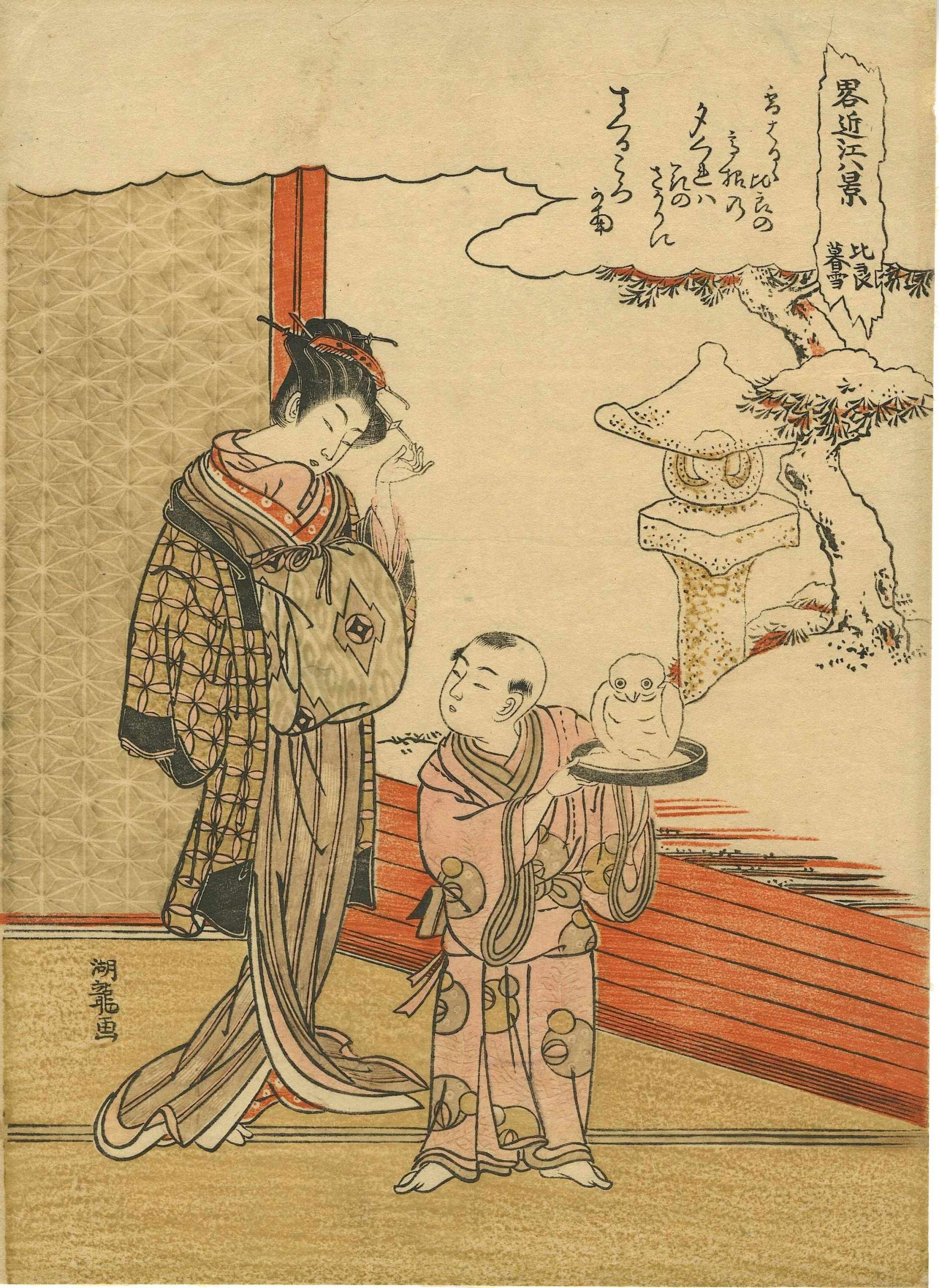 Evening Snow on Mount Hira (Hira no bosetsu), from the series Eight Views of Ōmi in Modern Guise (Ryaku Ōmi hakkei, (略近江八景). About 1773–75 (An'ei 2–4). Artist: Isoda Koryūsai (Japanese, 1735–1790) CATALOGUE RAISONNÉ: Hockley 2003, p. 202, #F-21-1 DIMENSIONS: Vertical chûban; 26 x 19.3 cm (10 1/4 x 7 5/8 in.)Signed: Koryû ga [湖竜画]
Evening Snow on Mount Hira (Hira no bosetsu), from the series Eight Views of Ōmi in Modern Guise (Ryaku Ōmi hakkei, (略近江八景). About 1773–75 (An'ei 2–4). Artist: Isoda Koryūsai (Japanese, 1735–1790) CATALOGUE RAISONNÉ: Hockley 2003, p. 202, #F-21-1 DIMENSIONS: Vertical chûban; 26 x 19.3 cm (10 1/4 x 7 5/8 in.)Signed: Koryû ga [湖竜画] -
 Artist: Utagawa Kuniyoshi [歌川 國芳] (Japanese, 1798 – 1861) Publisher: British Museum provides for the title as Enkyoku-zoroi [艶曲揃] (Set of Voluptuous Melodies) and the publisher as Sanpei. Indeed, 三平 (Sanpei) was a wholesale fan shop at the end of the Edo period. However, Andreas Marks identifies the publisher's seal as 三平 Mihei = Mikawaya Heiroku (1848-56), a member of the Fan Producing Guild (AM 11-016|325a). Block carver: Yokokawa Takejirō, seal: Carver Taki [彫竹] (Hori Take)
Artist: Utagawa Kuniyoshi [歌川 國芳] (Japanese, 1798 – 1861) Publisher: British Museum provides for the title as Enkyoku-zoroi [艶曲揃] (Set of Voluptuous Melodies) and the publisher as Sanpei. Indeed, 三平 (Sanpei) was a wholesale fan shop at the end of the Edo period. However, Andreas Marks identifies the publisher's seal as 三平 Mihei = Mikawaya Heiroku (1848-56), a member of the Fan Producing Guild (AM 11-016|325a). Block carver: Yokokawa Takejirō, seal: Carver Taki [彫竹] (Hori Take)Signed: Ichiyosai Kuniyoshi ga in a red cartouche and sealed with paulownia (kiri mon).
Date seal and double nanushi censor seals: Fuku & Muramatsu, 1853 (Kaei 6, 2nd month).
Size: Uchiwa-e (untrimmed fan print) 296 x 230 mm.

SVJP-0303.2019
-
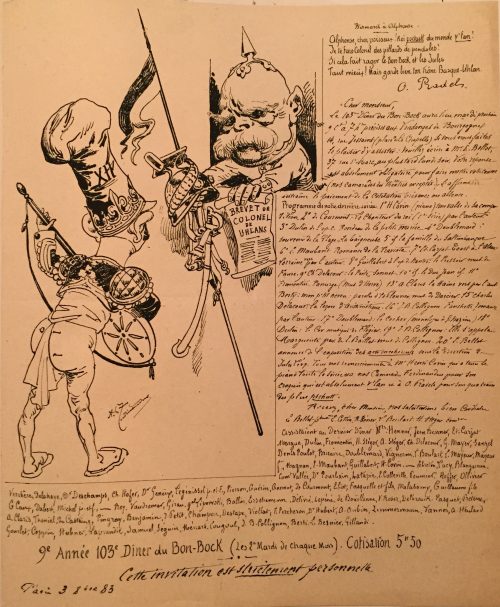
The 103rd Bon Bock Dinner Invitation
Artist: François Avenet a.k.a. Alexandre Ferdinandus (French, 1850 – 1888).
Cher monsieur, Le 103ème Dîner du Bon-Bock aura lieu mardi prochain / à 7h précises aux Vendanges de Bourgognel / 14, rue Jessaint (place de la Chapelle). Si vous nous faites le plaisir d’y assister : Veuillez écrire à Mr. E. Bellot, / 37 rue St Marc, au plus tard lundi soir. Votre réponse / est absolument obligatoire pour faire mettre votre couvert (nos camarades des théâtres exceptés.) L’affirmative entraine le paiement de la cotisation présence ou absence. / Programme de notre dernière soirée. 1e H Covin (piano) une valse de sa compo- / sition. 2e de Courment : Le Chanteur du roi (1ère série) par l’auteur. / 3e Dulin de l’o.p.e. Rondeau de la petite mariée 4e Doublemard : / souvenir de la Plage La baigneuse 5e "la famille des Saltimbanque" / 6e C. Maubant Romance de la Traviata. 7e Ct. Carjat Toast à l’Alsace-/Lorraine vers par l’auteur. 8e Guillabert de l’ap. de Nantes : le Pressoir mud. de / Faure . 9e Ch. Delacour : le Poete, Sonnet. 10e if. le Duc Jean if. 11e / Fromentin. Panurge (Mus. d’Hervé) 13e A. Claris la Haine vers par l’aut. / Benty : mon p’tit neveu : paroles d’Po Clouvier. mus. de Darcier. 15e Charles / Delacour : la leçon d’Arithmétique. 16e J.B. Collegnon Fanchette, romance/ par l’auteur. 17e Doublemard : le Cocher (monologue de P. Marzin) 18e / Dulin : le Cor musique de Flégier. 19e J. M. Collignon : Elle s’appela/ Marguerite par. De L. Baillet mus de Collignon. 20e L. Bellot / annonce de l’exposition des arts incohérents sous la direction de / Jules Féry. Tous nos remerciements à Mr. Henri Covin qui a tenu le/ piano toute la soirée et a nos Camarades Ferdinandus pour son / croquis qui est absolument v’lan et à O. Pradels pour son quatrain/ des plus pachutt. // Recevez, cher Monsieur, nos salutations bien Cordiale / E. Bellot, G durater E. Cottin, R. Géner, L. Bocilart, H. Héger comba / assistaient au Dernier Dîner Mrs : Henner, Jean Brenner, Et. Carjat / Margue, Dulin, Fromentin, H. Stéger, A . Stéger, eh. Delacour, G. Mayer, Sanzel/ Denis Poulot, Bricaire, Doublemard, Vigneron, T. Boulart, L. Mayeur, Mayeur/ flle, Magnan, E. Maubant, Guillabert, H. Corin. ___ Lebreton, Tucy, Blangarnon. / Comt. Vallée, Dr Pourbain, Latapie, E. Colleville, Roumier, Hoffer, Ollivier / Verchère, Delhaye, Dr Deschamps, Ch. Hofer, Dr Geneirp, Péginissel p, et F. , Pierson, Guérin, Cronnot, de Courmont, Eliot, Fasquelle et filsm Malasamy, Guillaume fils /G Caux, Dabert, Michel p, et f.s, ___Rey. Vaundremer, Girau, general Lipovvski, Ballin, Ersetemenn, Délivré, Lepéné, de Bouillanne, V. Roser, Delbroueth. Pasquet, Treterre, / A. Claris, Thoniel, du Castaings, Pingray, Benjamin, I. Petit, Champon, Destape, Viotlat, F. Percheron, Dr Hubert, A. Aubin, Zimmermann, Vannes, A. Heulard, / Gourlet, Coppin, Hubner, laprandie, Samuel, Séguin, Ménard, Cougoul, J. B. Collignon, Beri L. Besnier, Gillandi. // 9e Année 103e Diner du Bon-Bock (Les 2e Mardi de Chaque Mois). Cotisation 5h50 / Cette invitation est strictement personnelle / Paris 3 8bre 83.Bismarck à Alphonse
Alphonse, cher poissure! Roi pschutt du monde u’lan! Je te fais Colonel des pillards de pendules! Si cela fait rager le Bon-Bock et les Jules Tant mieux! Mais garde bien to Trône Basque-Uhlan. O. Pradels.
Bismarck to Alphonse Alphonse, dear annoyance! King shushh from the Uh'lan world I name you Colonel of the looters of pendulums! If this makes the Bon-Bock and Jules angry All the better! But protect your Basque-Uhlan throne well. O. Pradels.
Dear sir, The 103rd Dinner of the Bon-Bock will take place next Tuesday at 7 pm precisely at the Grape Harvest of Bourgognel, 14, Jessaint street (la Chapelle plaza). If you would do us the honour of coming: Please write to Mr E. Bellot, 37 St Marc street, on Monday night at the latest. Your answer is absolutely mandatory to prepare the place settings (our friends from the theatres excluded.) The 'yes' comes with a payment of the due whether or not you end up attending. Program for our last evening. 1st – H. Covin (piano) a waltz composed by him. 2nd – Courment: Le Chanteur du roi (King's singer) (1st series) by the author. 3rd – Dulin: Rondeau from opera "Le petite mariée" (The Little Bride) 4th – Doublemard: Memory of the bather's beach 5th – "The Saltimbanque family" 6th – Maubant: Romance of "La Traviata". 7th – Étienne Carjat Toast to the Alsace-Lorraine, verses by the author. 8th – Guillabert from the opera "Nantes: le Press mud" by Fauré. 9th – Charles Delacour: the Poet, Sonnet. 10th – "Duke Jean" 11th – Fromentin. Panurge (Mus. of Hervé) 13th – A. Claris "The Hatred" verses by the author, Benty: my lil’ nephew: lyrics by Clouvier, music by Darcier. 15th – Charles Delacour: the lesson in arithmetic. 16th – J.-B.Collegnon, "Fanchette", romance by the author. 17th – Doublemard: the Coach driver (monologue by P. Marzin). 18th – Dulin: the horn music by Flégier. 19th – J.-B. Collignon: "Her name was Marguerite", lyrics by L. Baillet music by Collignon. 20th – L. Bellot, an announcement from the incoherent arts exhibition curated by Jules Férry. All of our thanks to Mr Henri Covin who played the piano all night and to our Friends Ferdinandus for his sketch that is absolutely bam and to O. Pradels for his quatrain among the most pazazz worthy. We send you our most cordial salutation, Monsieur. E. Bellot, G. Durater, E. Cottin, R. Géner, L. Bocilart, H. Héger, Henner, Jean Brenner, Et. Carjat, Margue, Dulin, Fromentin, H. Stéger, A . Stéger, Ch. Delacour, G. Mayer, Sanzel, Denis Poulot, Bricaire, Doublemard, Vigneron, T. Boulart, L. Mayeur, Mayeur daugter, Magnan, E. Maubant, Guillabert, H. Corin. Lebreton, Tucy, Blangarnon. Comt. Vallée, Dr Pourbain, Latapie, E. Colleville, Roumier, Hoffer, Ollivier, Verchère, Delhaye, Dr. Deschamps, Ch. Hofer, Dr. Geneirp, Péginissel père et fils, Pierson, Guérin, Cronnot, de Courmont, Eliot, Fasquelle et fils Malasamy, Guillaume fils, G. Caux, Dabert, Michel père et fils, Rey. Vaundremer, Girau, General Lipovvski, Ballin, Ersetemenn, Délivré, Lepéné, de Bouillanne, V. Roser, Delbroueth, Pasquet, Treterre, A. Claris, Thoniel, du Castaings, Pingray, Benjamin, J. Petit, Champon, Destape, Viotlat, F. Percheron, Dr. Hubert, A. Aubin, Zimmermann, Vannes, A. Heulard, Gourlet, Coppin, Hubner, Laprandie, Samuel, Séguin, Ménard, Cougoul, J. B. Collignon, Berti, Besnier, Gillandi. 9th Year 103rd Dinner of the Bon-Bock (The 2nd Tuesdays of Each Month). Due 5:50 pm. This invitation is strictly personal. Paris 3 October 1883. Bismarck hands a certificate for the title of colonel along with a lance, an Uhlan helmet (Polish cavalry) and a sword to a joker. The joker wears a traditional Polish folk hat inscribed with 'XIV' and holds a guitar. ______ Comments: Émile Bellot [L. Bellot] (French, the second half of the 19th century) – engraver, model for a painting by Édouard Manet "Le bon bock", the founder of Le Bon Bock Dinner. Covin, Henri (French, 1845 – 1887) – Musician, arranger. Étienne Carjat (French, 1828 – 1906) – Journalist, caricaturist and photographer. Charles Delacour (French, 18.. – 1898) – Composer. Jean-Baptiste Collignon (French, 18..-1906) – Composer. Ange Flégier (French, 1846 – 1927) – Composer. Joseph Darcier (French, 1819 – 1883) – Composer, singer and actor. Le petite mariée (The Little Bride) – a three-act opéra-bouffe, music by Charles Lecocq, libretto by Eugène Leterrier and Albert Vanloo. La plage de la Baigneuse – beach of Saint Jean de Monts in the Vendée department in the Pays de la Loire region in western France. La Famille du Saltimbanque: L'Enfant Blessé – The Family of Street Acrobats: the Injured Child – painting by Gustave Doré (French, 1832 – 1883) produced in 1873. Henri-Polydore Maubant (1821-1902) – actor, vocalist (baritone) Gabriel Urbain Fauré (French, 1845 – 1924) – French composer, organist, pianist, and teacher. Hervé [Louis Auguste Florimond Ronger] (French, 1825 – 1892) – French singer, composer, librettist, conductor and scene painter, inventor of the genre of operetta in Paris. -
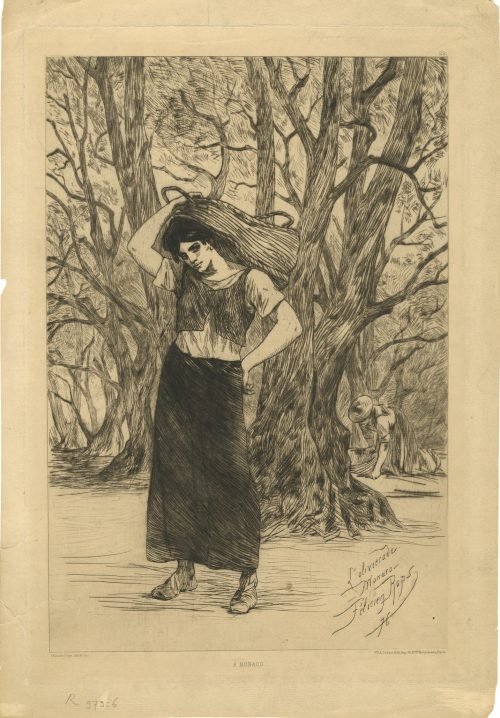
"In the olive grove", etching on laid paper. Signed on the plate and inscribed "L'olivierade Monaco, 76" (sic.). Owner's stamp LvM on verso.
Dimensions: Paper: 44 x 30.5 cm; Plate: 40 x 27 cm; Image: 35 x 24.5 cm.
Catalogue raisonné: Arthur Hubschmid (1977): 323; Graphics irreverent and erotic (1968): 323.
-
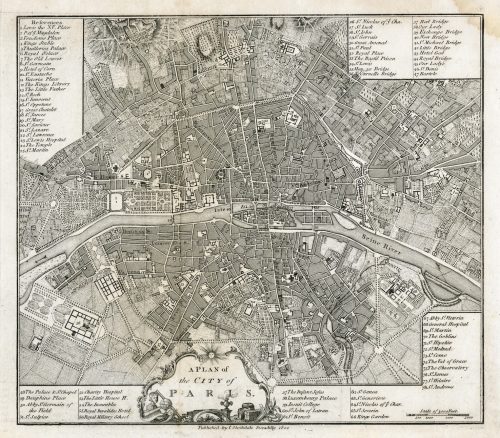 In pictorial frame: A PLAN of | the CITY of PARIS. || Under the border: Published by I. Stockdale Piccadilly 1800 || Dimensions: Sheet: 29 x 34.5 cm; Image: 22.7 x 25.9 cm.
In pictorial frame: A PLAN of | the CITY of PARIS. || Under the border: Published by I. Stockdale Piccadilly 1800 || Dimensions: Sheet: 29 x 34.5 cm; Image: 22.7 x 25.9 cm. -
 Kabuki actor: Matsumoto Kōshirō V [五代目松本幸四郎] (Japanese, 1764-1838); other names: Ichikawa Komazō III, Ichikawa Sumizō I. Role: Nikki Danjo (仁木弾正): "Evil retainer Nikki Danjo who plots to overthrow his lord in the play Precious incense and the bush clover of Sendai (Meiboku sendai hagi)" [R. Kruml]. Artist: Utagawa Kunisada [歌川 国貞] a.k.a. Utagawa Toyokuni III [三代歌川豊国] (Japanese, 1786 – 1865). Block cutter: Horikō (Kiyomizu) Ryūzō [彫工 柳三]. Publisher: Ebisuya Shoshichi [恵比寿屋庄七], Kinshōdō (Japanese, fl. c. 1846 – 1883). Year: 1863 (Bunkyū 3), 7th month. Size: Vertical ōban, hōsho paper. Signed: Nanajuhassai (aged seventy-eight) Toyokuni ga within toshidama cartouche. Censor’s seal: date-aratame. This print is from a series of portraits that Kunisada undertook very late in life and has been named Kinshodo-ban yakusha okubi-e (Kinshodo’s Large-Head Actor Portraits) in reference to the publisher, Ebisuya Shochochi of Kinshodo. The series depicted great actors in their famous roles from the past and present. Ref.: (1) [LIB-1212.2017] Robert Schaap. Kunisada: Imaging, drama and beauty. — Leiden: Hotei Publishing, 2016, p. 118 and 167 (№ 42):
Kabuki actor: Matsumoto Kōshirō V [五代目松本幸四郎] (Japanese, 1764-1838); other names: Ichikawa Komazō III, Ichikawa Sumizō I. Role: Nikki Danjo (仁木弾正): "Evil retainer Nikki Danjo who plots to overthrow his lord in the play Precious incense and the bush clover of Sendai (Meiboku sendai hagi)" [R. Kruml]. Artist: Utagawa Kunisada [歌川 国貞] a.k.a. Utagawa Toyokuni III [三代歌川豊国] (Japanese, 1786 – 1865). Block cutter: Horikō (Kiyomizu) Ryūzō [彫工 柳三]. Publisher: Ebisuya Shoshichi [恵比寿屋庄七], Kinshōdō (Japanese, fl. c. 1846 – 1883). Year: 1863 (Bunkyū 3), 7th month. Size: Vertical ōban, hōsho paper. Signed: Nanajuhassai (aged seventy-eight) Toyokuni ga within toshidama cartouche. Censor’s seal: date-aratame. This print is from a series of portraits that Kunisada undertook very late in life and has been named Kinshodo-ban yakusha okubi-e (Kinshodo’s Large-Head Actor Portraits) in reference to the publisher, Ebisuya Shochochi of Kinshodo. The series depicted great actors in their famous roles from the past and present. Ref.: (1) [LIB-1212.2017] Robert Schaap. Kunisada: Imaging, drama and beauty. — Leiden: Hotei Publishing, 2016, p. 118 and 167 (№ 42): Ref.: (1) [LIB-1197.2016] Arendie and Henk Herwig. Heroes of the kabuki stage: an introduction to kabuki with retellings of famous plays, illustrated by woodblock prints. — Amsterdam: Hotei Publishing, 2004; pp. 243-249.
Ref.: (1) [LIB-1197.2016] Arendie and Henk Herwig. Heroes of the kabuki stage: an introduction to kabuki with retellings of famous plays, illustrated by woodblock prints. — Amsterdam: Hotei Publishing, 2004; pp. 243-249.


-
 Artist: Utagawa Hiroshige II (二代目 歌川広重] (Japanese, 1826 – 1869). Signed: Hiroshige ga. Publisher: Iseya Sōemon [伊勢屋惣右衛門] (Japanese, c. 1776 – 1862); seal: Hanmoto, Ue [板元 上] (Marks 19-047 | 156d). Combined date seal and kiwame censor seal: Bunkyū 2 (1862) Media: Fan print (uchiwa-e, 団扇絵), 230 x 296 mm.
Artist: Utagawa Hiroshige II (二代目 歌川広重] (Japanese, 1826 – 1869). Signed: Hiroshige ga. Publisher: Iseya Sōemon [伊勢屋惣右衛門] (Japanese, c. 1776 – 1862); seal: Hanmoto, Ue [板元 上] (Marks 19-047 | 156d). Combined date seal and kiwame censor seal: Bunkyū 2 (1862) Media: Fan print (uchiwa-e, 団扇絵), 230 x 296 mm. -
 Artist: Utagawa Kunisada [歌川 国貞], a.k.a. Utagawa Toyokuni III [三代 歌川 豊国] (Japanese, 1786 – 1865). Signed: Toyokuni ga [豊国 画] in a red toshidama cartouche Block carver: Yokokawa Takejirō [横川竹二郎] (Japanese, fl. 1845 – 1863), seal: 彫竹 – hori Take. Publisher: Ibaya Senzaburō [伊場屋仙三郎] (Japanese, fl. c. 1845 – 1847). Media: Untrimmed fan print (uchiwa-e), 238 x 304 mm. Title: Saiko (West River) [西江]; 西江 means the Xi River in China. Series: Chronicles of Elegant Women [風雅女史傳] (Fūga joshiden). Combined date seal and kiwame censor seal: Ansei 6 (1859). Other prints from the same series in this collection: SVJP-0216.2016 — Princess Sotoori:
Artist: Utagawa Kunisada [歌川 国貞], a.k.a. Utagawa Toyokuni III [三代 歌川 豊国] (Japanese, 1786 – 1865). Signed: Toyokuni ga [豊国 画] in a red toshidama cartouche Block carver: Yokokawa Takejirō [横川竹二郎] (Japanese, fl. 1845 – 1863), seal: 彫竹 – hori Take. Publisher: Ibaya Senzaburō [伊場屋仙三郎] (Japanese, fl. c. 1845 – 1847). Media: Untrimmed fan print (uchiwa-e), 238 x 304 mm. Title: Saiko (West River) [西江]; 西江 means the Xi River in China. Series: Chronicles of Elegant Women [風雅女史傳] (Fūga joshiden). Combined date seal and kiwame censor seal: Ansei 6 (1859). Other prints from the same series in this collection: SVJP-0216.2016 — Princess Sotoori:

-
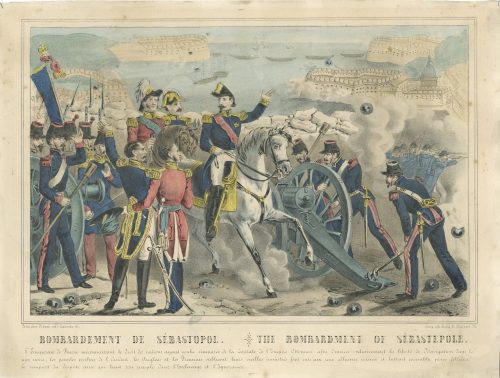 Hand-coloured lithography on wove paper, 250 x 332 mm; black ink stamp “5035” to reverse. Under the frame left: "Paris, chez Riboni, éd. r. Galande, 51"; right: "Paris, lith. Bulla, Pl. Maubert, 26". Below: "BOMBARDEMENT DE SEBASTOPOL. — THE BOMBARDMENT OF SÉBASTOPOLE". Text to bottom. Printers/publishers: Antoine Bulla (fl. 1815 – 1877), François Bulla (fl. c. 1814 – 1855).
Hand-coloured lithography on wove paper, 250 x 332 mm; black ink stamp “5035” to reverse. Under the frame left: "Paris, chez Riboni, éd. r. Galande, 51"; right: "Paris, lith. Bulla, Pl. Maubert, 26". Below: "BOMBARDEMENT DE SEBASTOPOL. — THE BOMBARDMENT OF SÉBASTOPOLE". Text to bottom. Printers/publishers: Antoine Bulla (fl. 1815 – 1877), François Bulla (fl. c. 1814 – 1855). -
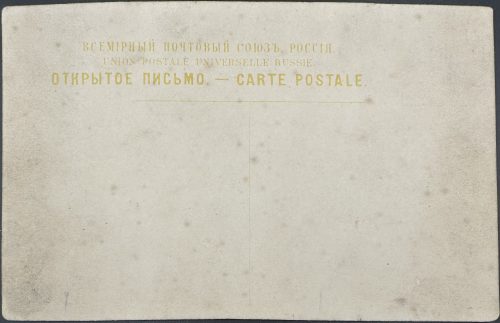 Ten postcards 90 x 140 mm, text in yellow "ВСЕМIРНЫЙ ПОЧТОВЫЙ СОЮЗЪ. РОССIЯ. | UNION POSTALE UNIVERSELLE RUSSIE. | ОТКРЫТОЕ ПИСЬМО. — CARTE POSTALE. || On the reverse, a blue ink woodcut image is printed in the upper left corner, and a идгу штл inscription is in the bottom centre. Holding the postcard against the backlight reveals a hidden image of an indecent nature (erotic). The use of Latin characters "R" and "N" instead of Russian "Р" and "Н" suggests that the cards were produced in Europe, probably in France. Inscriptions: 1. ПЕRВЫЕ ДNИ; 2. ПОRА ЛЮБВИ; 3. ВЪ ЛЮДИ; 4. КЪ "СВОБОДNОМУ ИСКУССТВУ"; 5. "СВОБОДNЫЙ ТRУДЪ; 6. БЕЗЪ ГОRЯ И ПЕЧАЛИ; 7. NАЗАДЪ КЪ "СВОБОДNОЙ ЛЮБВИ"; 8. ВСЕ ЧТО ОСТАЛОСЬ!; 9. БЕЗЪ КRОВА И ПRИСТАNИЩА; 10. ИЗЪ ЗА ХЛѢБА.
Ten postcards 90 x 140 mm, text in yellow "ВСЕМIРНЫЙ ПОЧТОВЫЙ СОЮЗЪ. РОССIЯ. | UNION POSTALE UNIVERSELLE RUSSIE. | ОТКРЫТОЕ ПИСЬМО. — CARTE POSTALE. || On the reverse, a blue ink woodcut image is printed in the upper left corner, and a идгу штл inscription is in the bottom centre. Holding the postcard against the backlight reveals a hidden image of an indecent nature (erotic). The use of Latin characters "R" and "N" instead of Russian "Р" and "Н" suggests that the cards were produced in Europe, probably in France. Inscriptions: 1. ПЕRВЫЕ ДNИ; 2. ПОRА ЛЮБВИ; 3. ВЪ ЛЮДИ; 4. КЪ "СВОБОДNОМУ ИСКУССТВУ"; 5. "СВОБОДNЫЙ ТRУДЪ; 6. БЕЗЪ ГОRЯ И ПЕЧАЛИ; 7. NАЗАДЪ КЪ "СВОБОДNОЙ ЛЮБВИ"; 8. ВСЕ ЧТО ОСТАЛОСЬ!; 9. БЕЗЪ КRОВА И ПRИСТАNИЩА; 10. ИЗЪ ЗА ХЛѢБА. -
 Artist: Torii Kiyonaga [鳥居 清長] (Japanese, 1752 – 1815) Color woodblock print: makimono-e (11.4 x 65.4 cm). Year: c. 1785. Three sheets of the series of twelve, № 6, № 9, and № 11, "from Kiyonaga's most idiosyncratic and celebrated series of pornography. It was designed as part of a miniature handscroll (makimono) to place in one's sleeve, where it was carried both for its stimulatory and for its talismanic properties." [LIB-1474.2018] Important Japanese prints from the collection of Henry Steiner by Sebastian Izzard.]№ 6: "The woman's blackened teeth indicate that she is a wife. This middle-aged couple is relaxing and drowsing after lovemaking. The scene is peaceful now., but the pillow cast aside hints at their earlier, passionate lovemaking".
Artist: Torii Kiyonaga [鳥居 清長] (Japanese, 1752 – 1815) Color woodblock print: makimono-e (11.4 x 65.4 cm). Year: c. 1785. Three sheets of the series of twelve, № 6, № 9, and № 11, "from Kiyonaga's most idiosyncratic and celebrated series of pornography. It was designed as part of a miniature handscroll (makimono) to place in one's sleeve, where it was carried both for its stimulatory and for its talismanic properties." [LIB-1474.2018] Important Japanese prints from the collection of Henry Steiner by Sebastian Izzard.]№ 6: "The woman's blackened teeth indicate that she is a wife. This middle-aged couple is relaxing and drowsing after lovemaking. The scene is peaceful now., but the pillow cast aside hints at their earlier, passionate lovemaking".
Picture № 6. (31d in LIB-2971.2022)
№ 9: "This looks to be the first sexual experience of a young woman of a well-to-do family, who covers her mouth shyly. The more experienced man moistens his fingers with saliva, eager to explore the young woman's body".
Picture № 9.
№ 11: "The woman wears a so-called Iwata sash signalling that she is pregnant. The man approaches from behind so as not to put pressure on her stomach. He shows care and gentle consideration toward his pregnant wife, who appears relaxed". Picture descriptions from Shunga: Sex and Pleasure in Japanese art. Edited by Timothy Clark, C. Andrew Gerstle, Aki Ishigami, Akiki Yano. Hotei Publishing, 2013. Ref.: [LIB-2971.2022] Chris Uhlenbeck, Margarita Winkel. Japanese erotic fantasies sexual imagery of the Edo period. — Amsterdam: Hotei Publishing, ©2005; p. 118-9 (№ 31).
Picture № 11. (31g in LIB-2971.2022)
-
 Katsukawa Shunshō ( 勝川 春章; 1726 – 19 January 1793).
Katsukawa Shunshō ( 勝川 春章; 1726 – 19 January 1793).Signed: Shunchô ga (春潮画); Censor's seal: kiwame (改印:極)
Publisher: Iwatoya Kisaburō (Eirindō); c. 1760s – 1832. Marks #173/p.169.
Reference: MFA ACCESSION NUMBER 11.21263. Not in Pins.
Act VII, Gion Ichiriki no ba ("The Ichiriki Teahouse at Gion") This act gives a taste of the bustling atmosphere of the Gion pleasure quarter in Kyoto. Yuranosuke is feigning a life of debauchery at the same teahouse to which Okaru has been indentured. Kudayū, the father of Sadakurō, arrives. He is now working for Moronō and his purpose is to discover whether Yuranosuke still plans revenge or not. He tests Yuranosuke's resolve by offering him food on the anniversary of their lord's death when he should be fasting. Yuranosuke is forced to accept. Yuranosuke's sword – the revered symbol of a samurai – is also found to be covered in rust. It would appear that Yuranosuke has no thoughts of revenge. But still unsure, Kudayū hides under the veranda. Now believing himself alone, Yuranosuke begins to read a secret letter scroll about preparations for the vendetta. On a higher balcony Okaru comes out to cool herself in the evening breeze and, noticing Yuranosuke close by, she also reads the letter reflected in her mirror. As Yuranosuke unrolls the scroll, Kudayū, too, examines the end which trails below the veranda. Suddenly, one of Okaru's hairpins drops to the floor and a shocked Yuranosuke quickly rolls up the scroll. Finding the end of the letter torn off, he realises that yet another person knows his secret and he must silence them both. Feigning merriment, he calls Okaru to come down and offers to buy out her contract. He goes off supposedly to fix the deal. Then Okaru's brother Heiemon enters and, hearing what has just happened, realises that Yuranosuke actually intends to keep her quiet by killing her. He persuades Okaru to let him kill her instead so as to save their honour and she agrees. Overhearing everything, Yuranosuke is now convinced of the pair's loyalty and stops them. He gives Okaru a sword and, guiding her hand, thrusts it through the floorboards to kill Kudayū. The main actor has to convey a wide variety of emotions between a fallen, drunkard rōnin and someone who in reality is quite different since he is only faking his weakness. This is called hara-gei or "belly acting", which means he has to perform from within to change characters. It is technically difficult to perform and takes a long time to learn, but once mastered the audience takes up on the actor's emotion. Emotions are also expressed through the colours of the costumes, a key element in kabuki. Gaudy and strong colours can convey foolish or joyful emotions, whereas severe or muted colours convey seriousness and focus. -
 Artist: Utagawa Kuniyoshi [歌川 國芳] (Japanese, 1798 – 1861).
Artist: Utagawa Kuniyoshi [歌川 國芳] (Japanese, 1798 – 1861).Title: Suzume fukube [美人団扇絵] (Sparrow and gourds).
Series: Kacho awase [花鳥合] (Collection of flowers and birds).
Publisher: Aritaya Seiemon [有田屋 清右衛門] (Japanese, fl. c. 1830 – 1862); Seal: Marks 17-011 | 014d.Signed: Ichiyosai Kuniyoshi ga in a red cartouche and sealed with paulownia crest (kiri mon).
Size: Uchiwa-e (untrimmed fan print) 296 x 230 mm.
Double nanushi censor seals: Kinugasa & Watanabe, Kaei 2-3 (1849–50).
Ref.: Kuniyoshi Project. -
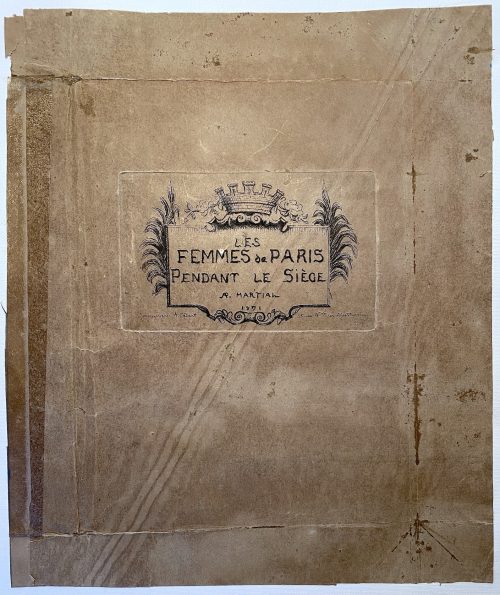 A suite of 12 etchings 160 x 118 mm each, in the first state, pasted on paper, 2 per sheet, with a cover (250 x 210 mm).0. Cover. Les femmes de Paris pendant le siège./R.Martial/1871.1. Lorsqu'à l'approche de l'ennemi on demandait l'éloignement des bouches inutiles [...] 2. L'Ennemi ! 3. No inscription 4. Quête pour les veuves. 5. Concert et quête pour les enfants blessés, malades, infirmes. 6. Au bastion/Et celles non moins précieuses qui dirigeaient ces ventes [...] 7. Vente pour les orphelins de la guerre. 8. No inscription 9. Une ration, bouillie romaine et Vin/Cantine municipale[...] 10. No inscription 11. No inscription 12. Les effets de cette union patriotique des femmes sont connus.[...]
A suite of 12 etchings 160 x 118 mm each, in the first state, pasted on paper, 2 per sheet, with a cover (250 x 210 mm).0. Cover. Les femmes de Paris pendant le siège./R.Martial/1871.1. Lorsqu'à l'approche de l'ennemi on demandait l'éloignement des bouches inutiles [...] 2. L'Ennemi ! 3. No inscription 4. Quête pour les veuves. 5. Concert et quête pour les enfants blessés, malades, infirmes. 6. Au bastion/Et celles non moins précieuses qui dirigeaient ces ventes [...] 7. Vente pour les orphelins de la guerre. 8. No inscription 9. Une ration, bouillie romaine et Vin/Cantine municipale[...] 10. No inscription 11. No inscription 12. Les effets de cette union patriotique des femmes sont connus.[...] -
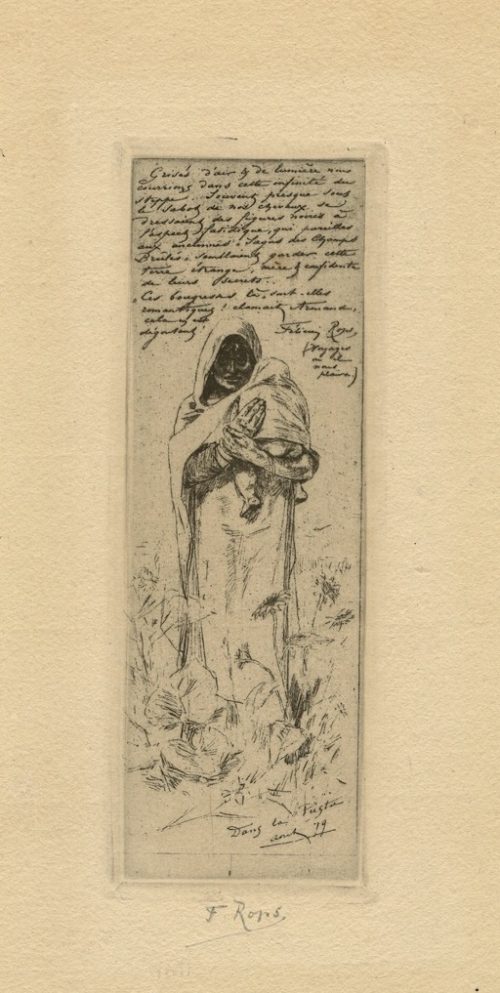
Etching and drypoint, signed in pencil by the artist under the plate; 2nd state. Pasted on a sheet of blue paper. Fragment of "La messe de Gnide". Owner's stamp 'LvM' on verso.
Dimensions: Blue paper: 32 x 27 cm; Laid paper: 30.7 x 22 cm; Image: 12.5 x 4 cm.
Catalogue raisonné: Arthur Hubschmid (1977): 364; Graphics irreverent and erotic (1968): 59; Rouir: 508.
-
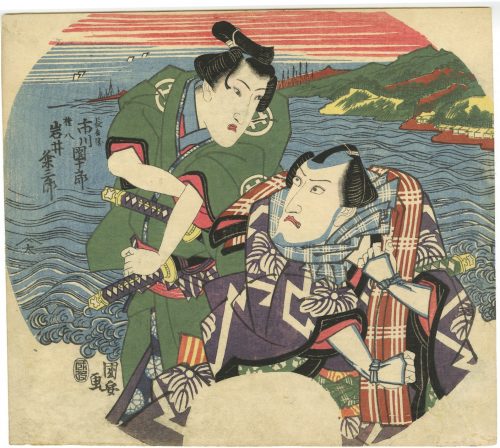 Artist: Utagawa Kuniyasu [歌川 国安] (Japanese, 1794–1832). Publisher seal: [太] (Ta): Marks 02-050 | U421b: An unknown publisher in Edo, fl. c. 1815-61; name assigned according to seal shape “Yama-Ta“. Signed: Kuniyasu ga [国安 画]. Date-aratame seal: Bunsei 9 (1826). Actors: Iwai Hanshirō VI [岩井半四郎] (Japanese, 1799 – 1836), other names: Iwai Hanshirō VI, Iwai Kumesaburō II, Iwai Hisajirō I, Baiga (poetry name), Shūka (poetry name) — as Shirai Gonpachi [白井權八]. Ichikawa Danjūrō VII 市川団十郎 (Japanese, 1791 – 1859), other names: Ichikawa Ebizō V, Ichikawa Hakuen II, Ichikawa Shinnosuke I — as Banzui Chōbei [幡随長兵衛]. Kabuki play: Suzugamori [Suzu-ga-Mori, 鈴ヶ森], a.k.a. Ukiyozuka Hiyoku no Inazuma written by Tsuruya Nanboku IV (Japanese, c. 1755 – 1829). First staged in 1823 at Ichimura-za [市村座] in Edo. Plot: "A gang of evil palanquin bearers are stationed near the Suzugamori execution grounds, where they lay in wait to rob travellers passing through. Gonpachi, who killed a man in his home province, is being sought by the police. He is fleeing to Edo when the bearers attack him in hopes of claiming a reward. He beats them off with great skill. Banzui Chōbei, who is being carried by in a palanquin, sees the attack, admires Gonpachi's ability, and promises to aid him if he is going to Edo". [Samuel L. Leiter. Historical Dictionary of Japanese Traditional Theatre. — Rowman & Littlefield, 2014; p. 382-3.; LIB-2110.2019]. Ref.: Sotheby's.
Artist: Utagawa Kuniyasu [歌川 国安] (Japanese, 1794–1832). Publisher seal: [太] (Ta): Marks 02-050 | U421b: An unknown publisher in Edo, fl. c. 1815-61; name assigned according to seal shape “Yama-Ta“. Signed: Kuniyasu ga [国安 画]. Date-aratame seal: Bunsei 9 (1826). Actors: Iwai Hanshirō VI [岩井半四郎] (Japanese, 1799 – 1836), other names: Iwai Hanshirō VI, Iwai Kumesaburō II, Iwai Hisajirō I, Baiga (poetry name), Shūka (poetry name) — as Shirai Gonpachi [白井權八]. Ichikawa Danjūrō VII 市川団十郎 (Japanese, 1791 – 1859), other names: Ichikawa Ebizō V, Ichikawa Hakuen II, Ichikawa Shinnosuke I — as Banzui Chōbei [幡随長兵衛]. Kabuki play: Suzugamori [Suzu-ga-Mori, 鈴ヶ森], a.k.a. Ukiyozuka Hiyoku no Inazuma written by Tsuruya Nanboku IV (Japanese, c. 1755 – 1829). First staged in 1823 at Ichimura-za [市村座] in Edo. Plot: "A gang of evil palanquin bearers are stationed near the Suzugamori execution grounds, where they lay in wait to rob travellers passing through. Gonpachi, who killed a man in his home province, is being sought by the police. He is fleeing to Edo when the bearers attack him in hopes of claiming a reward. He beats them off with great skill. Banzui Chōbei, who is being carried by in a palanquin, sees the attack, admires Gonpachi's ability, and promises to aid him if he is going to Edo". [Samuel L. Leiter. Historical Dictionary of Japanese Traditional Theatre. — Rowman & Littlefield, 2014; p. 382-3.; LIB-2110.2019]. Ref.: Sotheby's. -
 Artist: Utagawa Kunisada [歌川 国貞] a.k.a. Utagawa Toyokuni III [三代歌川豊国] (Japanese, 1786 – 1865). Signed: Kōchō(rō) Kunisada ga (香蝶国貞画) in a red double-gourd cartouche. Publisher: Surugaya Sakujirō [駿河屋作次郎] (Japanese, fl. c. 1844 – 1865); Marks 06-005 | 501a. Single nanushi censor seal: Muramatsu (1843-6). The date is attributed to c. 1844. Title: Narihira [なり平]. Ariwara no Narihira [在原 業平] (Japanese, 825 – 880) – one of the Six Immortal Poets – The Rokkasen [六歌仙]. Series: A parody of six immortal poets [見立六花撰] (Mitate Rokkasen). Media: Untrimmed fan print (uchiwa-e), 227 x 293 mm, depicting a beautiful woman with a bow and arrows in her left hand. Series: Mitate Rokkasen [見立六花撰] – is sometimes interpreted as "A parody of six immortal poets" or "A comparison of six select flowers". [LIB-1212.2017] Robert Schaap. Kunisada: Imaging, drama and beauty. — Leiden: Hotei Publishing, 2016; pl. 28, p. 58. This is another fan print with another immortal poet, Bun'ya no Yasuhide [文屋 康秀] (Japanese, -d. 885?), from the same series, provided in the book:With special thanks to Horst Graebner for help with the description and date attribution: "The print can be dated to 1844: censor seal is Muramatsu (Muramatsu Genroku); he acted in 7/1844 and 4/1845 (and also later) as censor but Kunisada changed his name to Kunisada early in 1844."
Artist: Utagawa Kunisada [歌川 国貞] a.k.a. Utagawa Toyokuni III [三代歌川豊国] (Japanese, 1786 – 1865). Signed: Kōchō(rō) Kunisada ga (香蝶国貞画) in a red double-gourd cartouche. Publisher: Surugaya Sakujirō [駿河屋作次郎] (Japanese, fl. c. 1844 – 1865); Marks 06-005 | 501a. Single nanushi censor seal: Muramatsu (1843-6). The date is attributed to c. 1844. Title: Narihira [なり平]. Ariwara no Narihira [在原 業平] (Japanese, 825 – 880) – one of the Six Immortal Poets – The Rokkasen [六歌仙]. Series: A parody of six immortal poets [見立六花撰] (Mitate Rokkasen). Media: Untrimmed fan print (uchiwa-e), 227 x 293 mm, depicting a beautiful woman with a bow and arrows in her left hand. Series: Mitate Rokkasen [見立六花撰] – is sometimes interpreted as "A parody of six immortal poets" or "A comparison of six select flowers". [LIB-1212.2017] Robert Schaap. Kunisada: Imaging, drama and beauty. — Leiden: Hotei Publishing, 2016; pl. 28, p. 58. This is another fan print with another immortal poet, Bun'ya no Yasuhide [文屋 康秀] (Japanese, -d. 885?), from the same series, provided in the book:With special thanks to Horst Graebner for help with the description and date attribution: "The print can be dated to 1844: censor seal is Muramatsu (Muramatsu Genroku); he acted in 7/1844 and 4/1845 (and also later) as censor but Kunisada changed his name to Kunisada early in 1844."
Robert Schaap, 2016.
-
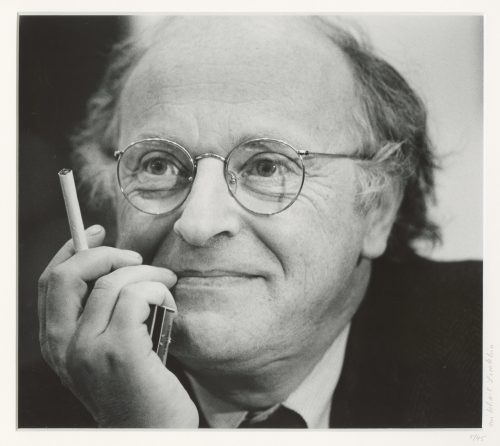 Photographic portrait of poet Joseph Brodsky, head, hand, and shoulder, three-quarters to the left, wearing glasses and with a cigarette. Pencil-signed on the mat: 5/45 • Mikhail Lemkhin; same inscription on the back of the print, and ink stamp ©Mikhail Lemkhin. Sitter: Joseph Brodsky [Иосиф Александрович Бродский ] (Russian-American-Jewish, 1940 – 1996). Size: mat: 41 x 51 cm; window: 27 x 30 cm; print: 27.7 x 35.4 cm.
Photographic portrait of poet Joseph Brodsky, head, hand, and shoulder, three-quarters to the left, wearing glasses and with a cigarette. Pencil-signed on the mat: 5/45 • Mikhail Lemkhin; same inscription on the back of the print, and ink stamp ©Mikhail Lemkhin. Sitter: Joseph Brodsky [Иосиф Александрович Бродский ] (Russian-American-Jewish, 1940 – 1996). Size: mat: 41 x 51 cm; window: 27 x 30 cm; print: 27.7 x 35.4 cm. -
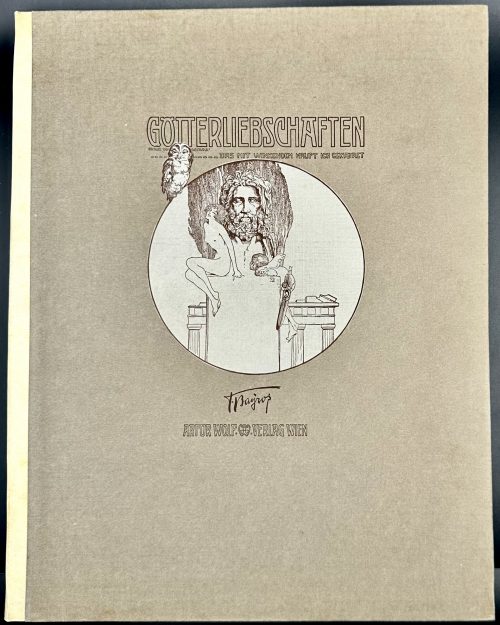 Letterpress title-page, engraved title-page, and 10 sheets of collotype plates printed on india paper mounted on thick wove paper, with captioned guard sheets, loose in a vellum-backed cardboard portfolio with cloth-mounted flaps; floral diaper design inside throughout; bookseller's label to front board verso; limited edition of 550 copies of which this is copy № 103. Dimensions: 338 x 268 mm portfolio; 325 x 260 mm sheet, 225 x 195 mm image. Front board with lettering and vignette: GÖTTERLIEBSCHAFTEN | DAS MIT WINKENDEM HAUPT ICH GEWAHRET | {vignette} | {signature} | ARTUR WOLF / VERLAG WIEN || Letterpress title-page: FRANZ VON BAYROS | “GÖTTERLIEBSCHAFTEN” | ARTUR WOLF / VERLAG WIEN | 1914 || Verso to letterpress t.p. VERZEICHNIS DER TAFELN.
Letterpress title-page, engraved title-page, and 10 sheets of collotype plates printed on india paper mounted on thick wove paper, with captioned guard sheets, loose in a vellum-backed cardboard portfolio with cloth-mounted flaps; floral diaper design inside throughout; bookseller's label to front board verso; limited edition of 550 copies of which this is copy № 103. Dimensions: 338 x 268 mm portfolio; 325 x 260 mm sheet, 225 x 195 mm image. Front board with lettering and vignette: GÖTTERLIEBSCHAFTEN | DAS MIT WINKENDEM HAUPT ICH GEWAHRET | {vignette} | {signature} | ARTUR WOLF / VERLAG WIEN || Letterpress title-page: FRANZ VON BAYROS | “GÖTTERLIEBSCHAFTEN” | ARTUR WOLF / VERLAG WIEN | 1914 || Verso to letterpress t.p. VERZEICHNIS DER TAFELN.- Europa und der Stier
- Leda und die Schildkröte
- Sterope und Herkules
- Herodikos und die Turnerinnen
- Phoroneus und die Hirtin
- Minos und Persipeia
- Phryne und Mutter
- Pytalos und Demeter
- Kirke und die Ferkel
- Putiphar
-
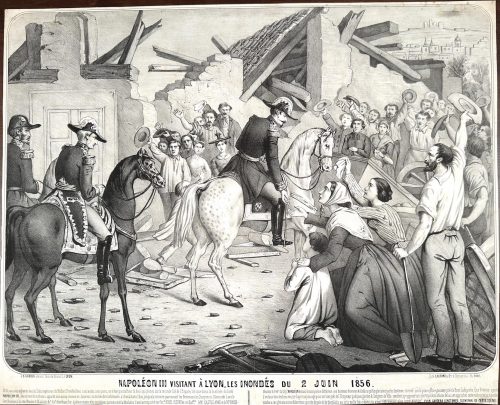 Lithography poster on wove paper, 492 x 614 mm; black ink stamp “5036” to reverse, vertical centerfold. Image in frame; under the frame left: "J. B. Gadola, éditeur. Cours de Brosses 1, à LYON."; right: "Lith LAURANT & Cie r. de Bernardins 34, Paris." Title and text below the image. Jean-Baptiste Gadola (French, 1818 – 1870) – publisher.
Lithography poster on wove paper, 492 x 614 mm; black ink stamp “5036” to reverse, vertical centerfold. Image in frame; under the frame left: "J. B. Gadola, éditeur. Cours de Brosses 1, à LYON."; right: "Lith LAURANT & Cie r. de Bernardins 34, Paris." Title and text below the image. Jean-Baptiste Gadola (French, 1818 – 1870) – publisher.







